In June of 2022, I filmed a segment on a very small resident of Lake Jackson. It was a crustacean discovered before the June 2021 dry down of the lake, and that had never been seen since. Crangonyx apalachee, as it is known, had been found in grasses at the edge of the lake. By June of 2022, the lake had refilled somewhat, but still, the critter was nowhere to be found.
Despite sampling water bodies throughout the panhandle, Dr. Tom Sawicki and his lab haven’t found C. apalachee anywhere else. It seems the creature is endemic to the lake. It evolved with Lake Jackson’s periodic dry downs; in other words, it has figured out what to do when its grassy habitat goes dry for months at a time.
In the meantime, Tom noticed that as the edge of water moves, the vegetation changes. The shoreline didn’t have the same grasses as when his graduate student found the small amphipod. This revelation spurred me to start visiting the lake more regularly, to see how it changed over time. This resulted in a segment on bird watching on Lake Jackson during a dry down. Birds respond as submerged lake bottom become mud flats, and water rises and drops along the contour of the lake edge making new bars and islands.
After that segment, I started returning periodically because, well— I keep seeing cool things here. This is a page where I’ll keep adding photos over time. In the last two months (writing in June of 2023), the lake has dried down again. As I write this, spring is in full flush, which means plant growth and migration. Between the seasonality and the dynamic hydrology of the lake, it regularly becomes a new place.
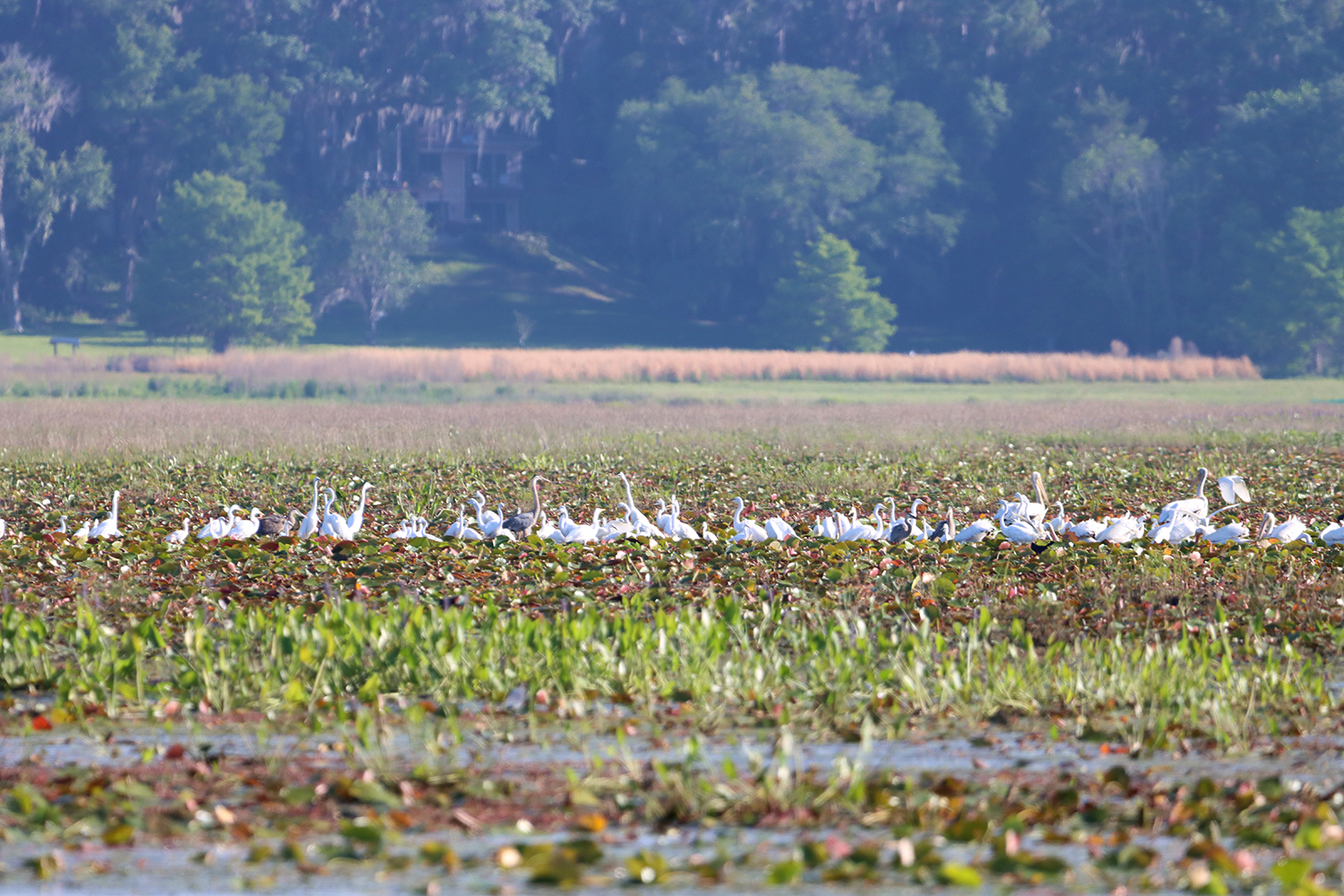
April 25, 2023
a sign of change to come
It was random luck that brought me here today. A month after I finished my spot on bird watching in Lake Jackson, it had been holding water since late January. Lake Jackson Aquatic Preserve manager Cait Snyder said the lake loses water more slowly in the winter, as many plants are dormant and they drink less water.
It was surprisingly active. For the first time since right after the June ’21 dry down, I saw wood storks. On that day I only saw one, but there were quite a few today.
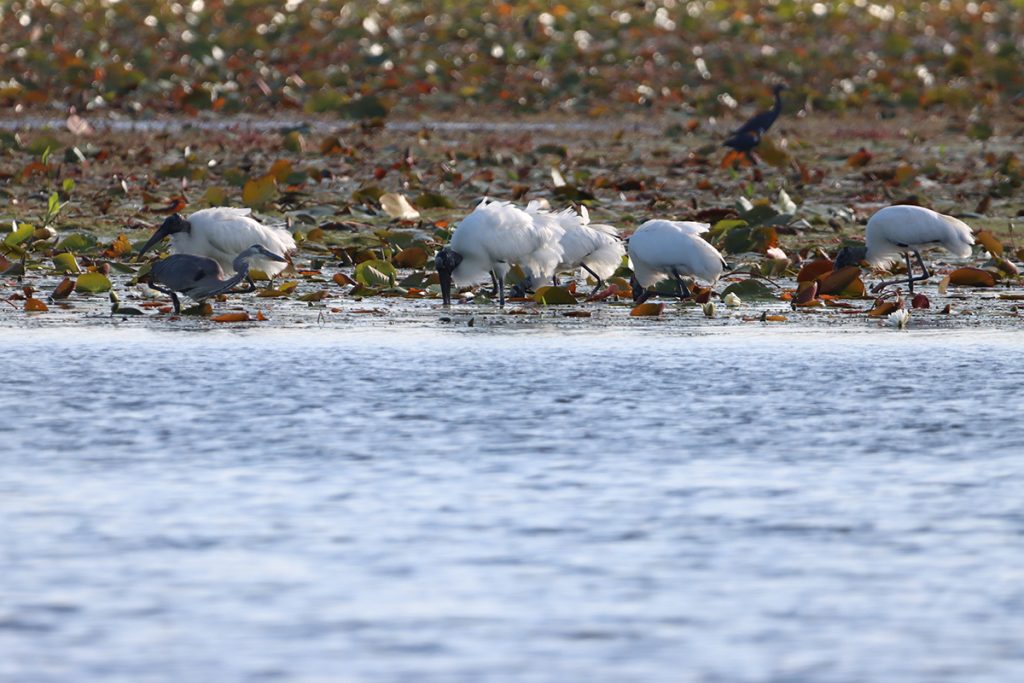
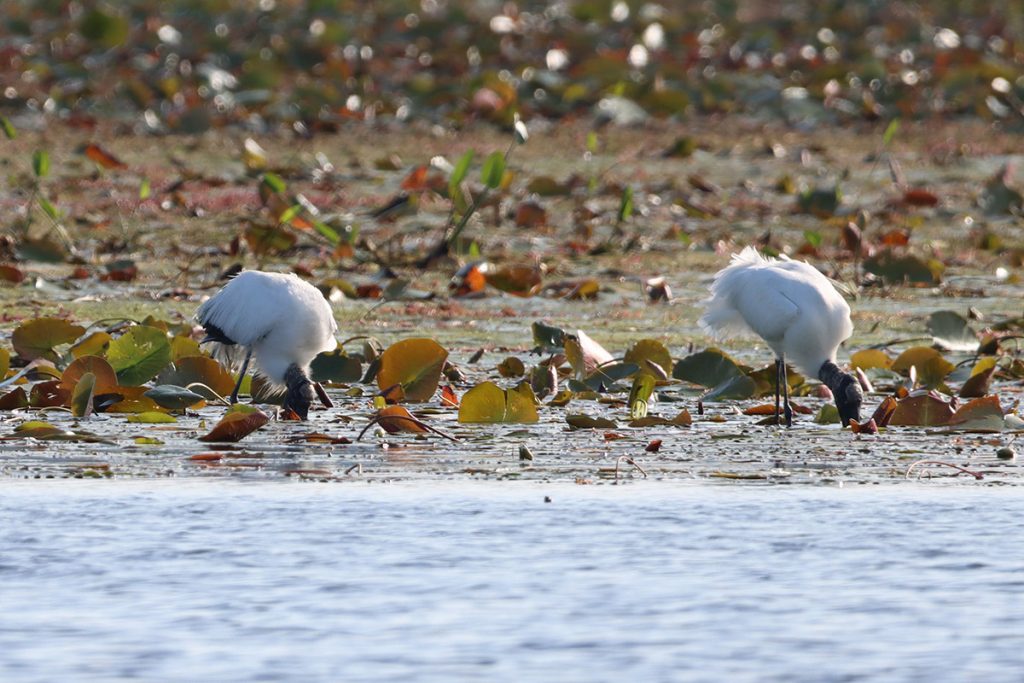
Cait wrote to tell me that wading birds this active might signal an impending dry down. She’d noticed the lake was lower, and could start to the see the channels that led water into Porter Sink. Shallower water allows wading birds to feed more easily, and they flocked to this section of the lake.

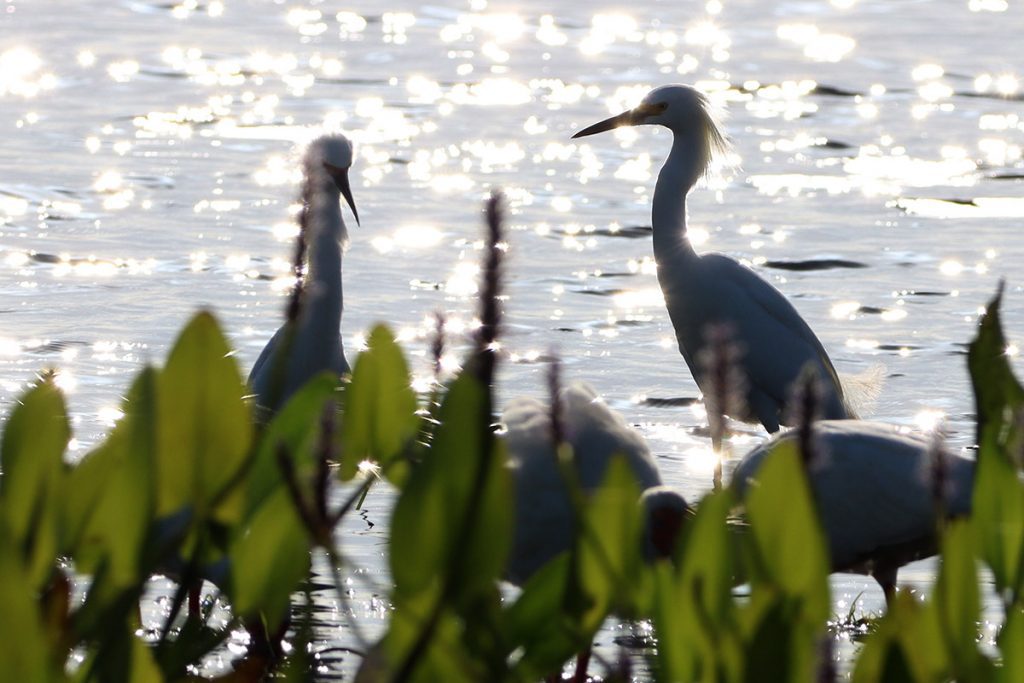
Pickerelweed was in full bloom, drinking that lake water.
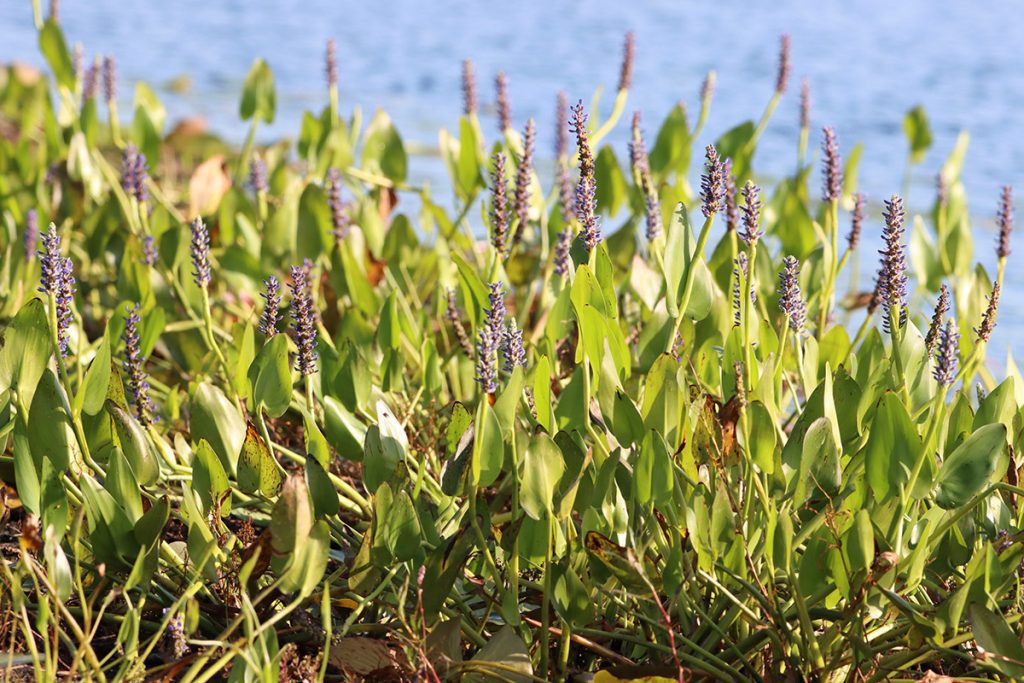

May 4, 2023
Shortly after dry down.
The wading birds (and Cait) were right. Within a couple days of my last visit, the lake dried down.


Wading birds love those first days after a dry down. Expanses of mucky earth are exposed, as well as the invertebrates found in it. Fish, tadpoles, and other aquatic creatures are concentrated into small pools, reducing the effort needed to eat them.
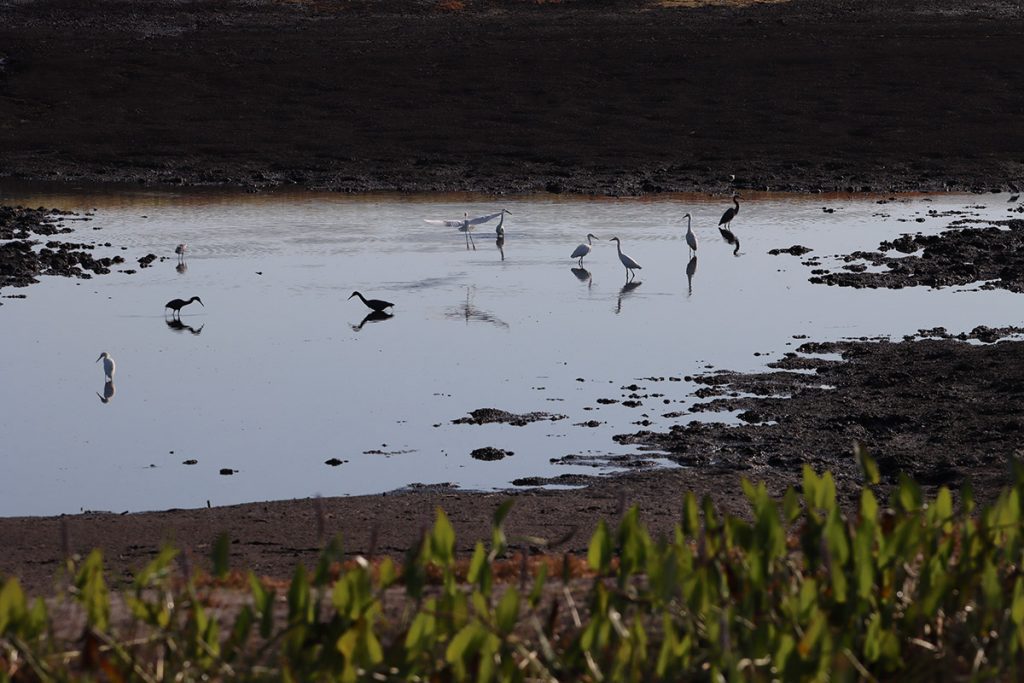
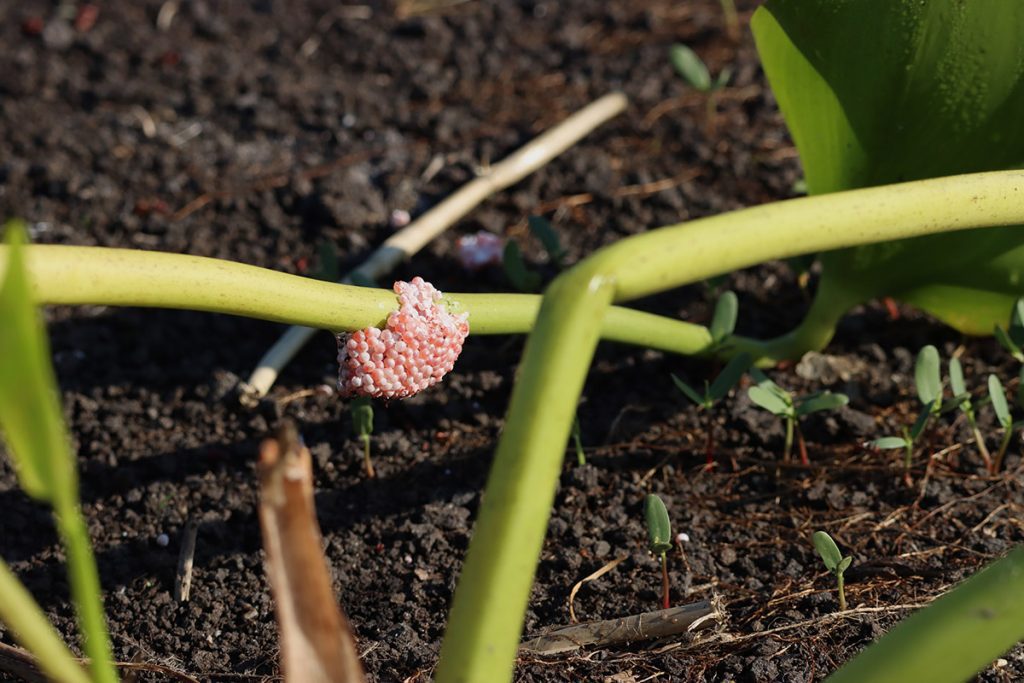
Florida apple snails lay white eggs— these are invasive. Island apple snails are destructive to native vegetation, and yet they feed a healthy population of limpkins on the lake.
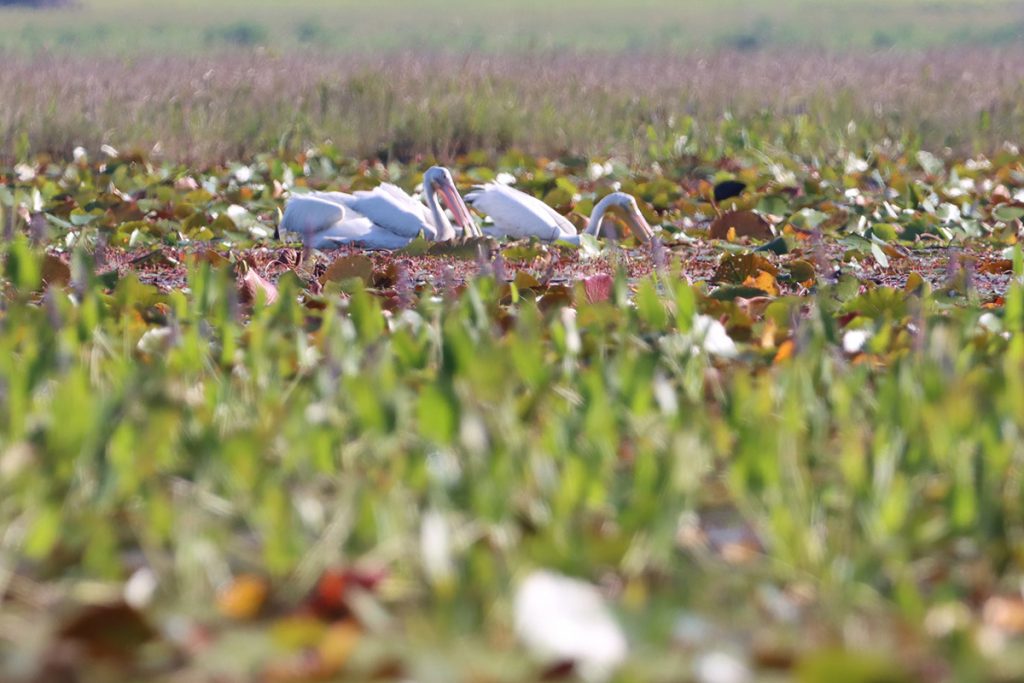
When the lake dries down, not all of it goes all the way dry. The shallow water here has food for these pelicans.
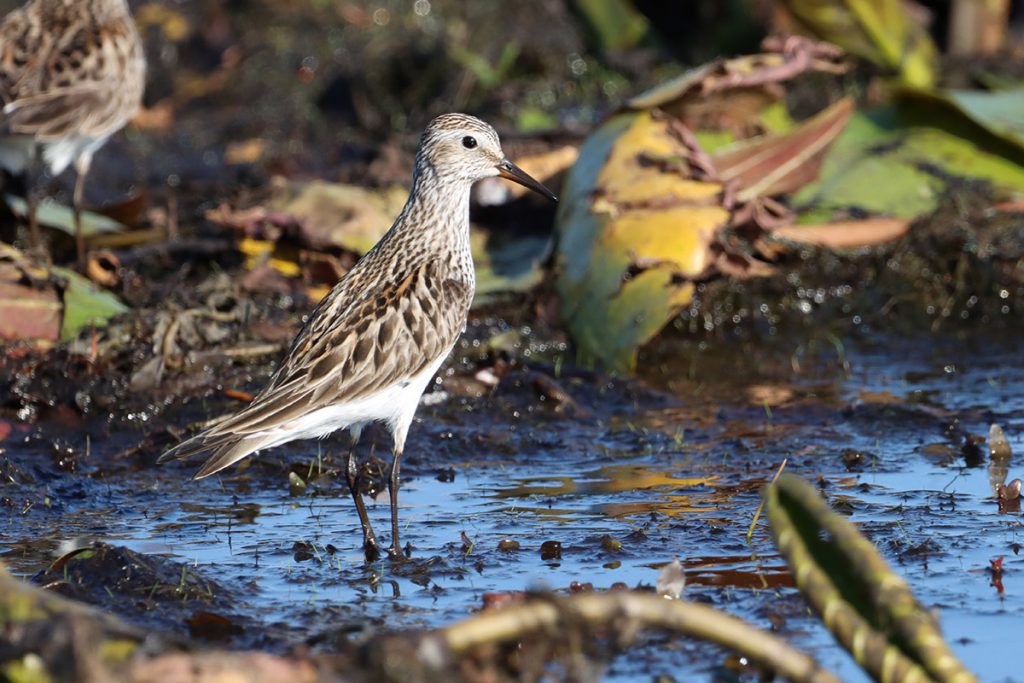
Several sandpipers pecked the muck where water trickled down into the sink. These are migratory birds who nest in the moist tundra of the arctic.
Walking around the edge of the sink, I spotted an animal one keeps at a distance.

Florida softshell turtles lack a hard shell, which they compensate for by being aggressive with their sharp claws and teeth. I snapped photos of it for a while before it climbed down into the sink basin.
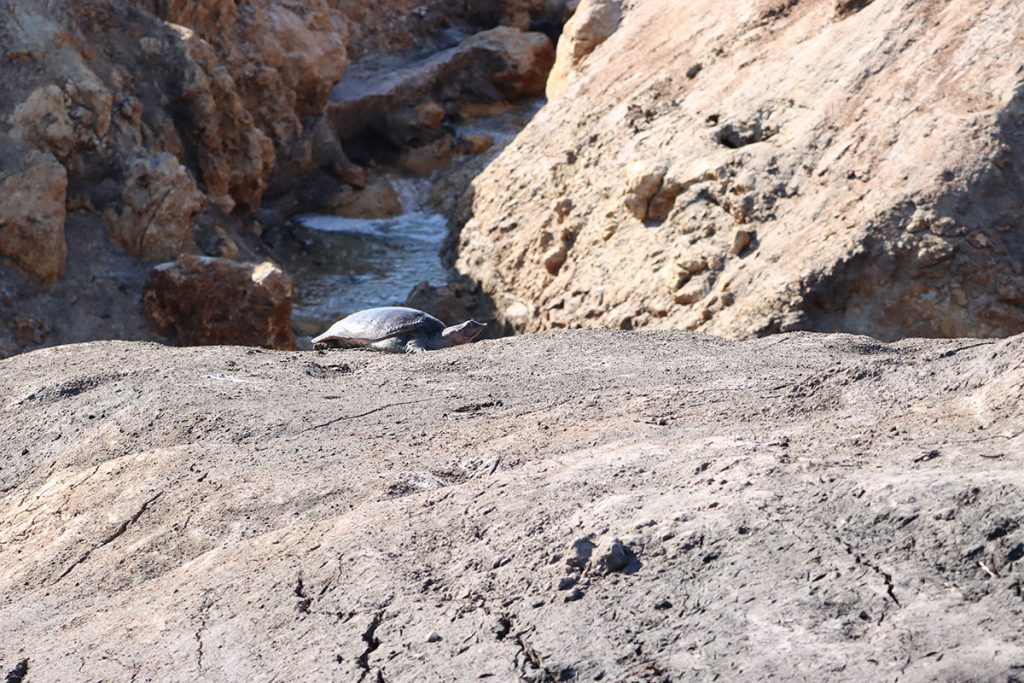
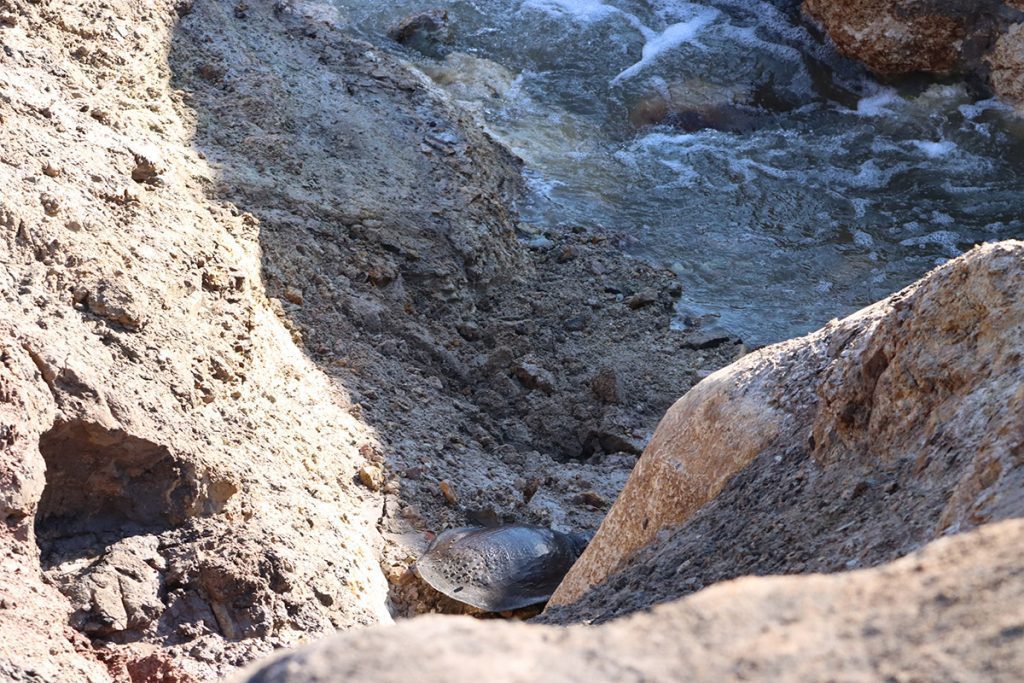
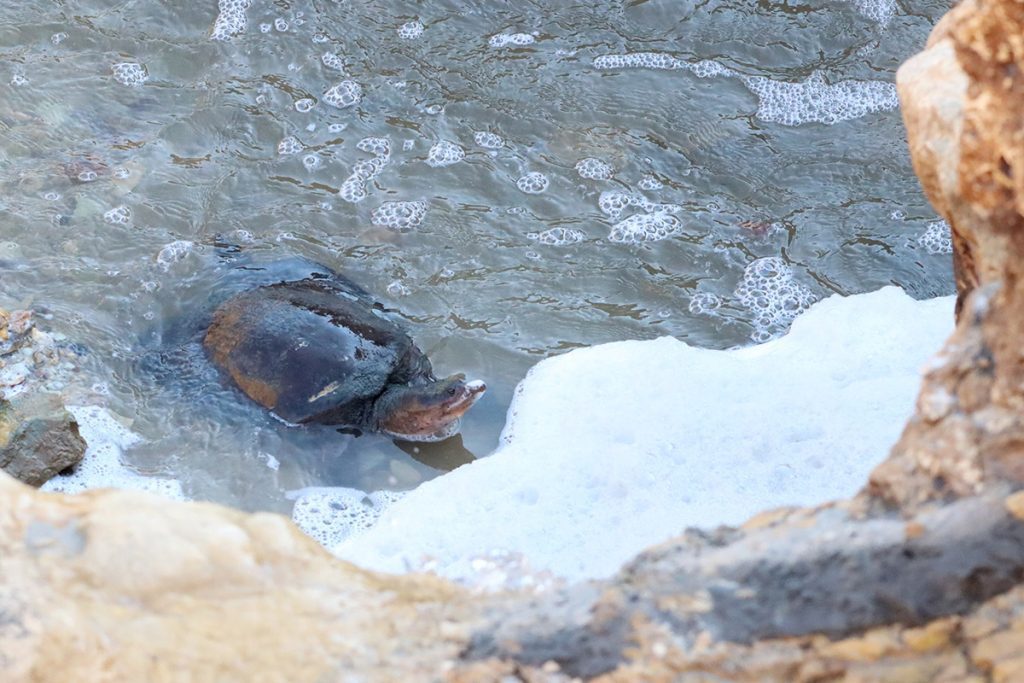
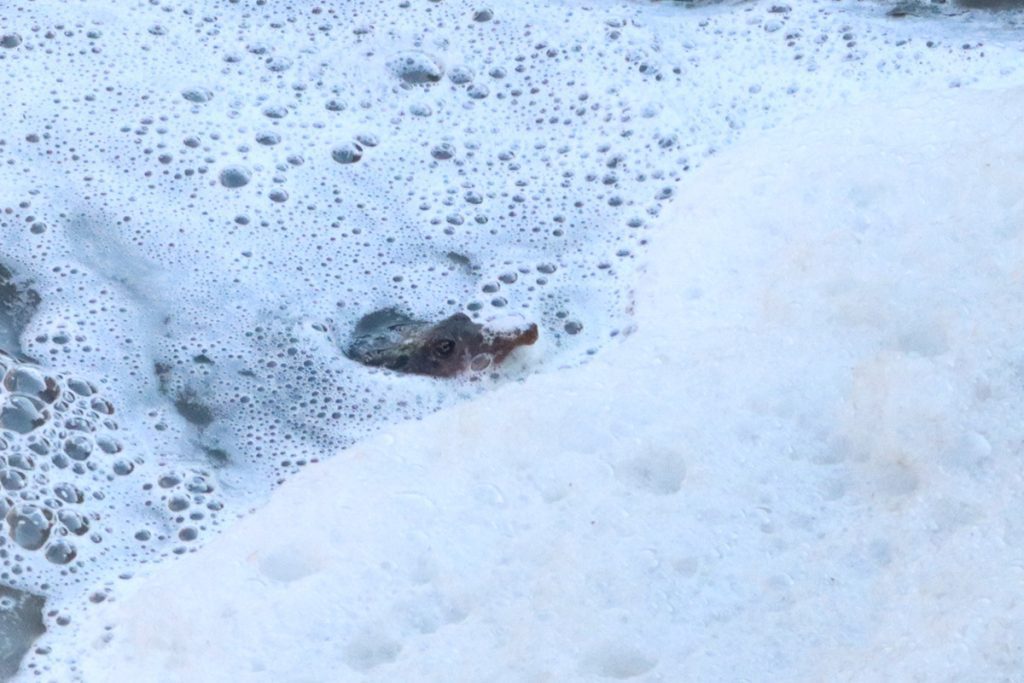
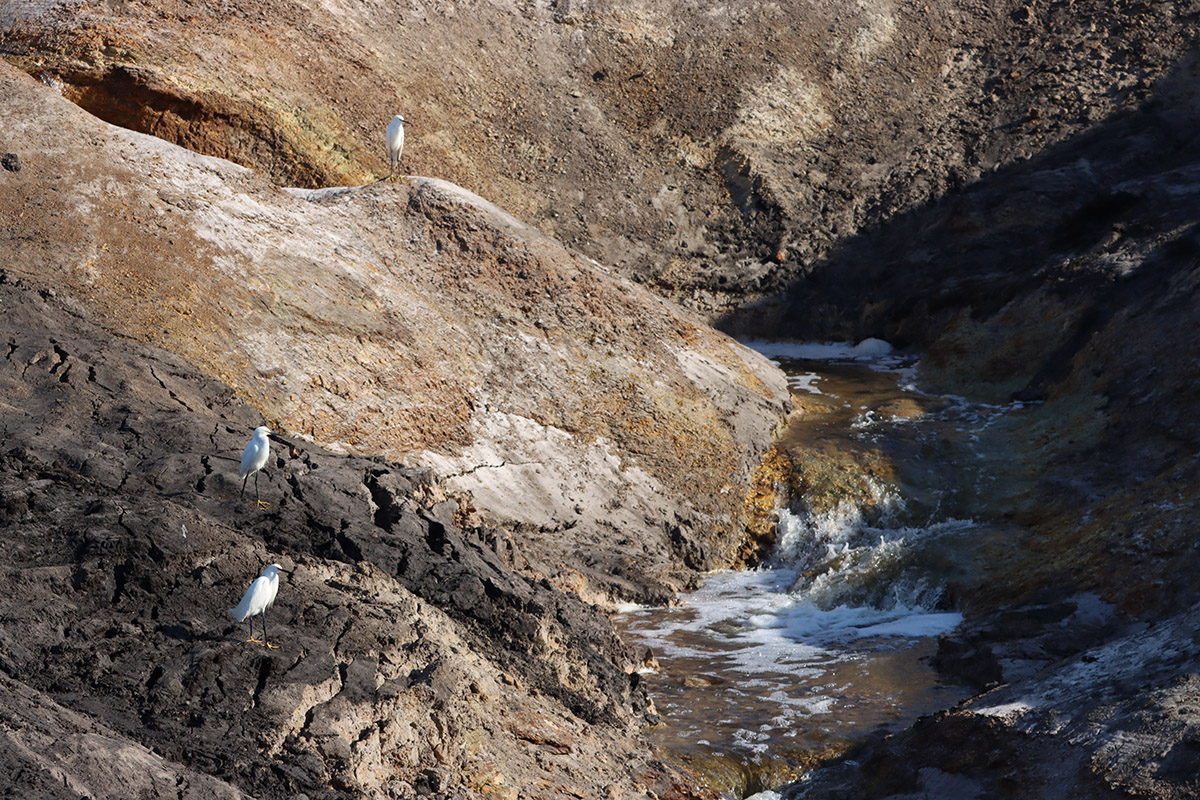
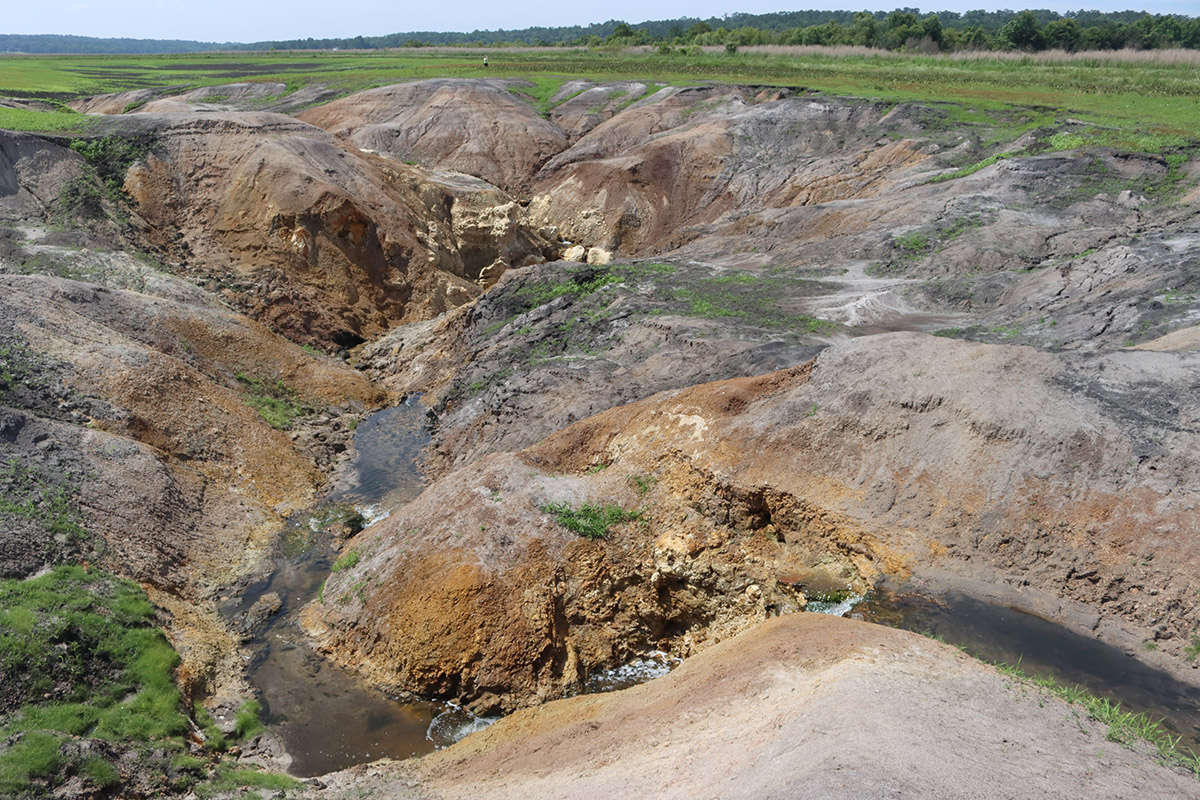
June 2, 2023
Kites and the end of a salamander
It had been almost a month, and so I thought I’d check in. The exposed lake bottom has gotten a lot greener.
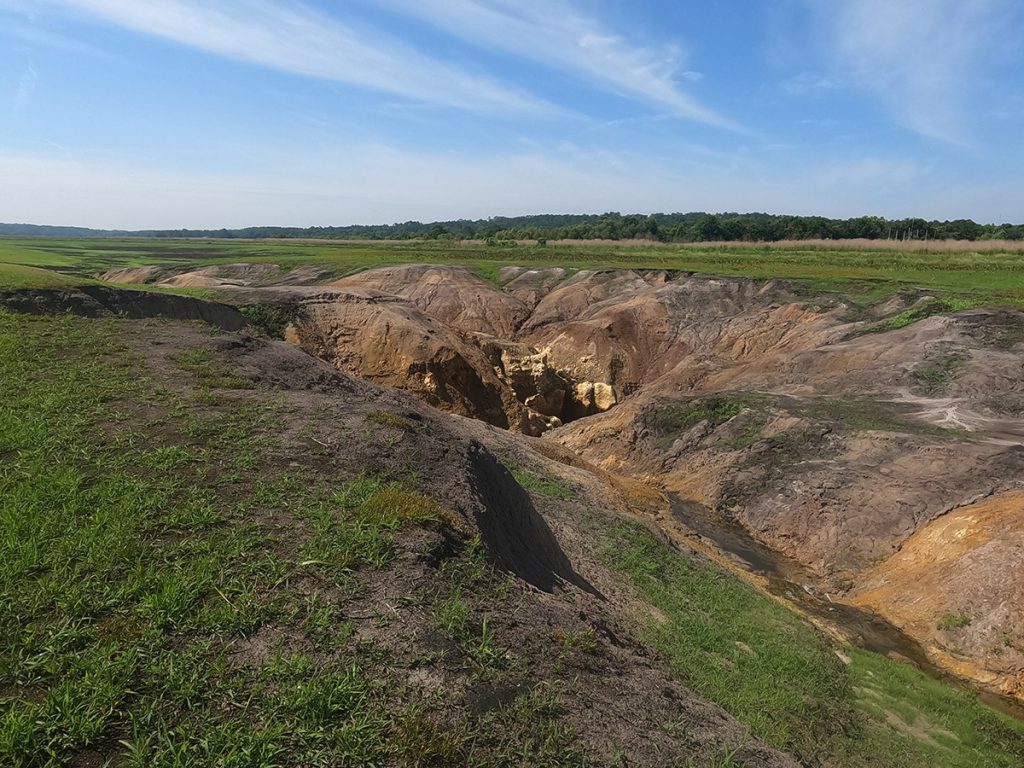

As I walked through, saw what I thought might be the nonnative chamberbitter all over the mudflats. I admit my mistake and am editing this section (July 13, 2023). This is native bigpod sesbania, a plant that at this size looks very much similar– they’re both legumes with similar leaf patterns. The sesbania will get much larger, though, and produce yellow flowers.
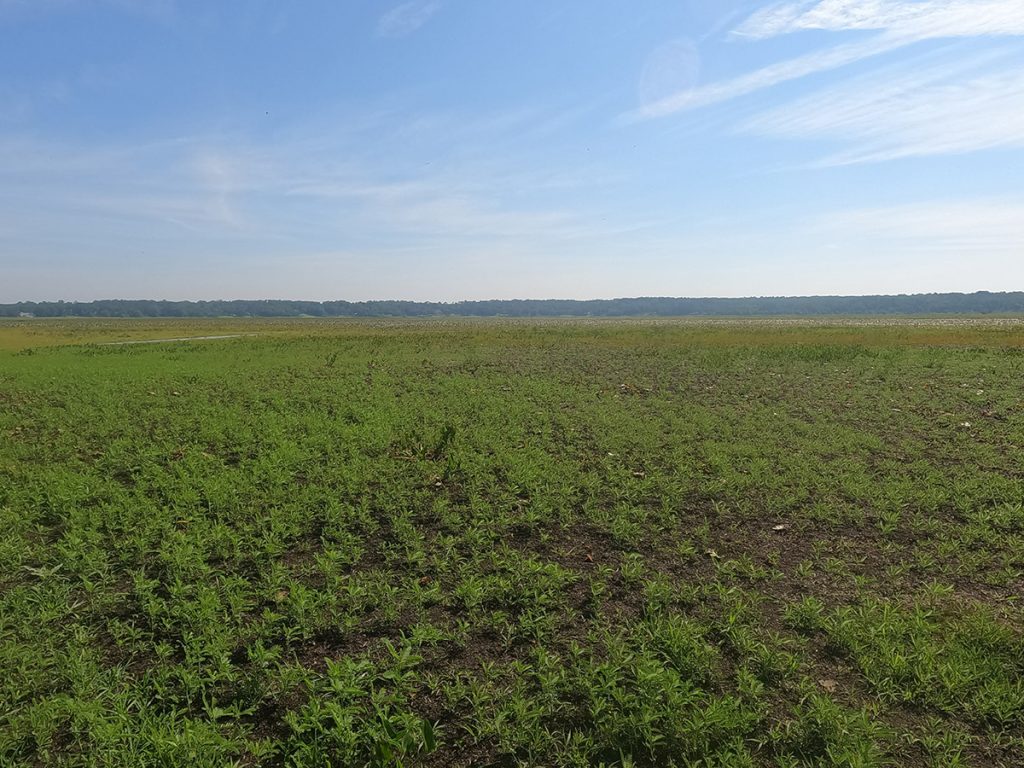
The pools by Faulk Drive Landing were lower than on my last visit, despite recent rains. Wading birds seem to like newly risen or fallen water. The lake has been down a month, and it was quiet. And then I spotted a great blue heron in the distance.
Zooming in, I could see it had something. Too short for a snake, I thought maybe it was an eel. But I checked with Cait— eels are not present in Lake Jackson. From what I read, freshwater eels migrate up from salt water, so it’s unlikely one finds its way into the lake.
The heron’s prey is likely an amphiuma or siren— large salamanders with small limbs. Tasty.
As I was walking back to Faulk Landing, I looked up and saw birds circling.
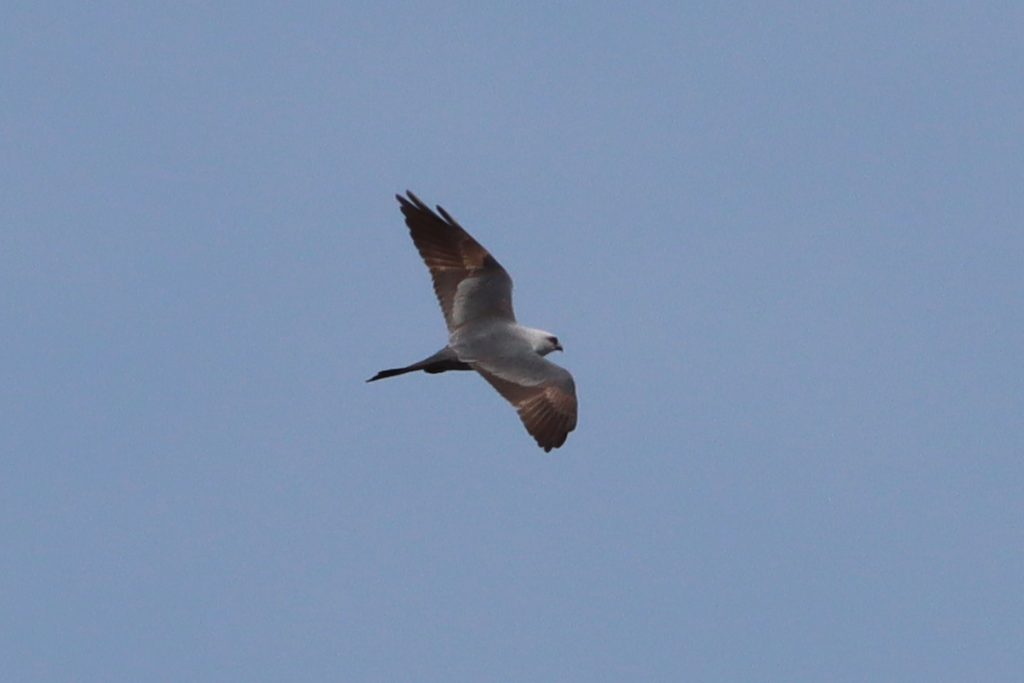
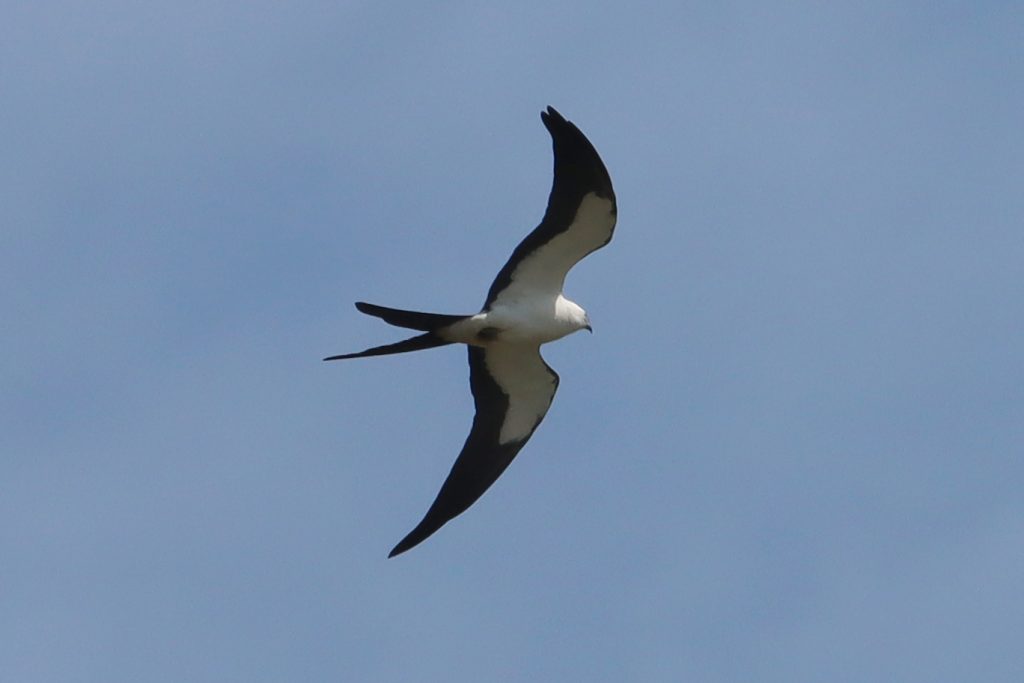
Two species of migratory kites visiting from South America. They fly to North America to nest in the spring, and return in the late summer. Both species circled overhead with vultures. Few birds are as recognizable as a swallowtail kite overhead. I’ve had trouble photographing them in the past because they quickly disappear over a tree line. I had not yet been fast enough. In the wide open lake bottom, I could see them move towards and away from me, giving me time to get ready.

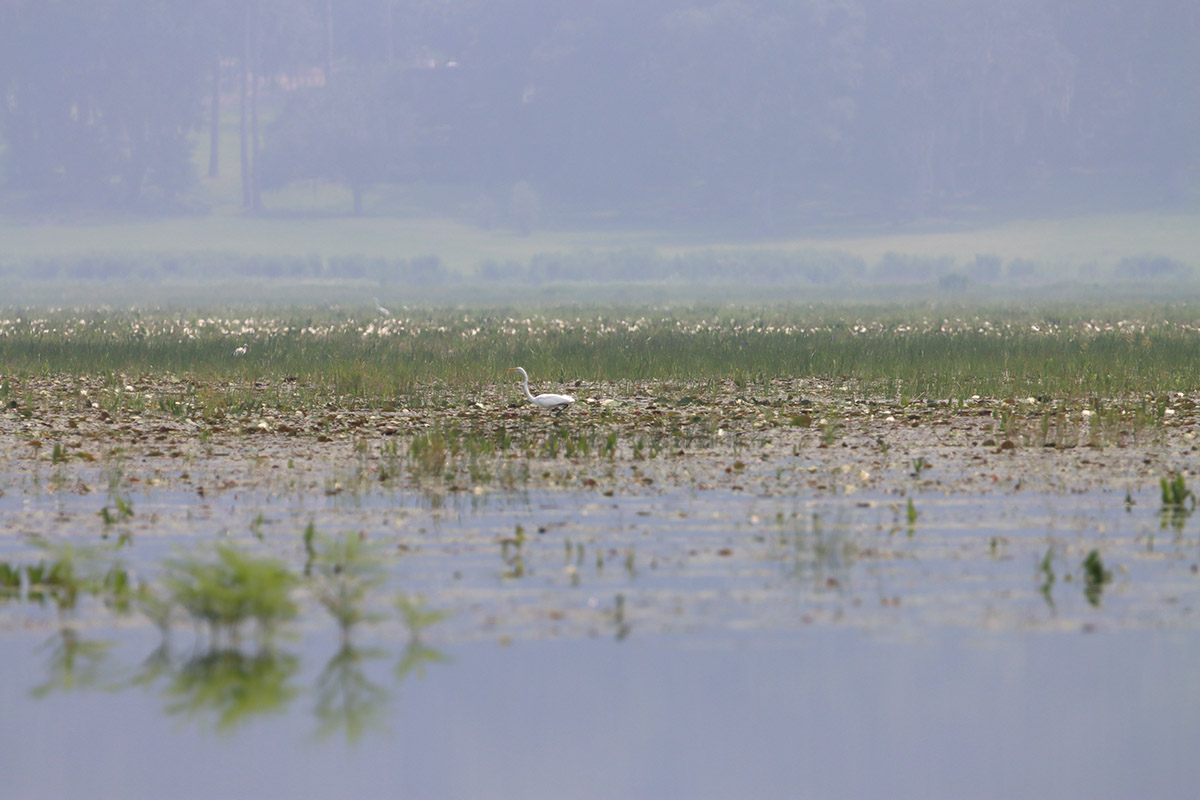
July 18, 2023
Full of water, full of flowers
I went on vacation right as rains had finally started to fill the basin thoroughly enough to keep cover over the sinkhole. I badly wanted to capture the birds as the edge of water moved once again, and then again after that. It did rain a bit while I was gone, and from what I saw on social media, it filled in stages. Well, I can’t be everywhere all the time.
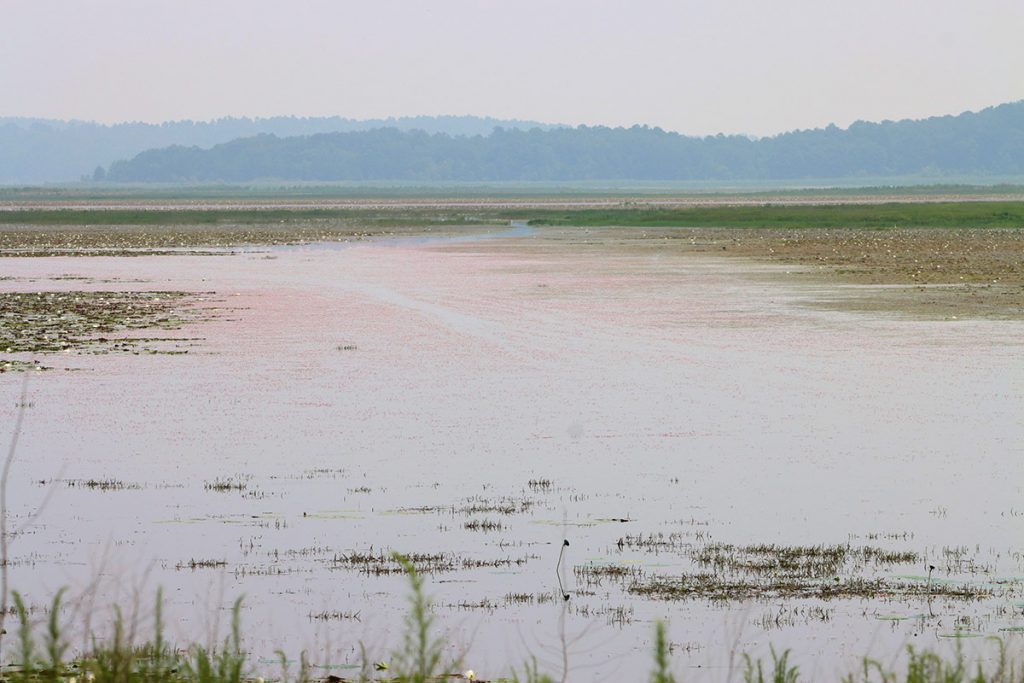
I stopped at Faulk landing and the Highway 27 boat ramp. Let’s start with the Jackson View Landing, as the 27 boat ramp is called. Now that the lake is full, I’ve been contemplating a kayak trip, and I was thinking of launching here. I couldn’t help but notice a red tinge to the water. Freshwater red tide? No.

Let’s look a little closer. Are those little flowers floating on the surface of the lake?
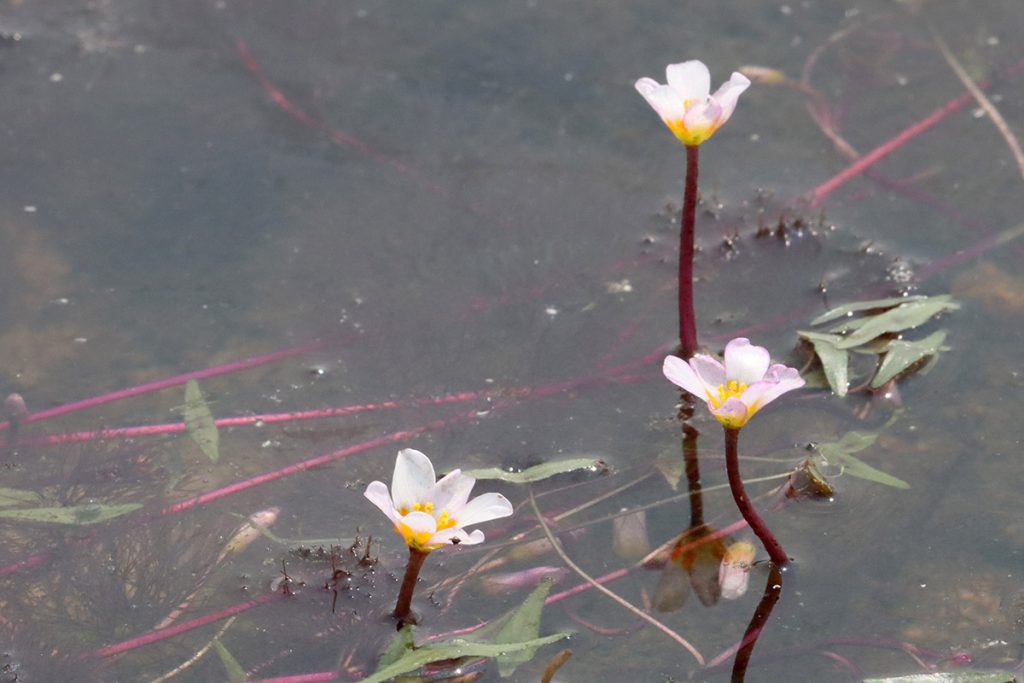
I think the flowers further out might be the same as this smaller group I found closer to the ramp. Unfortunately, if this is the case, this part of the lake is covered by a non-native plant. It’s pretty, but I don’t like the look of a nonnative plant being so widespread here. This popular aquarium plant is mostly submerged, with flowers poking out to attract pollinators.
Lake Jackson was full of flowers today, in and out of the water. The summer growing season is in full swing, and there’s more water for aquatic plants.
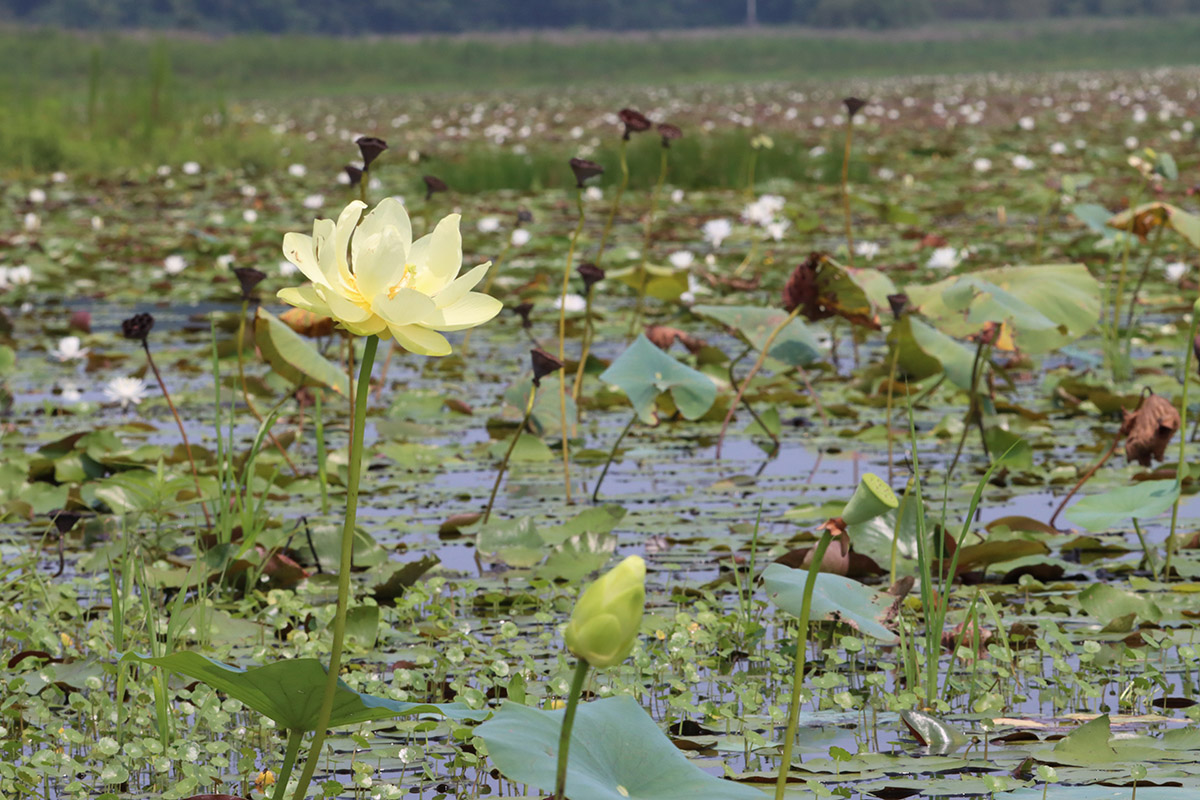
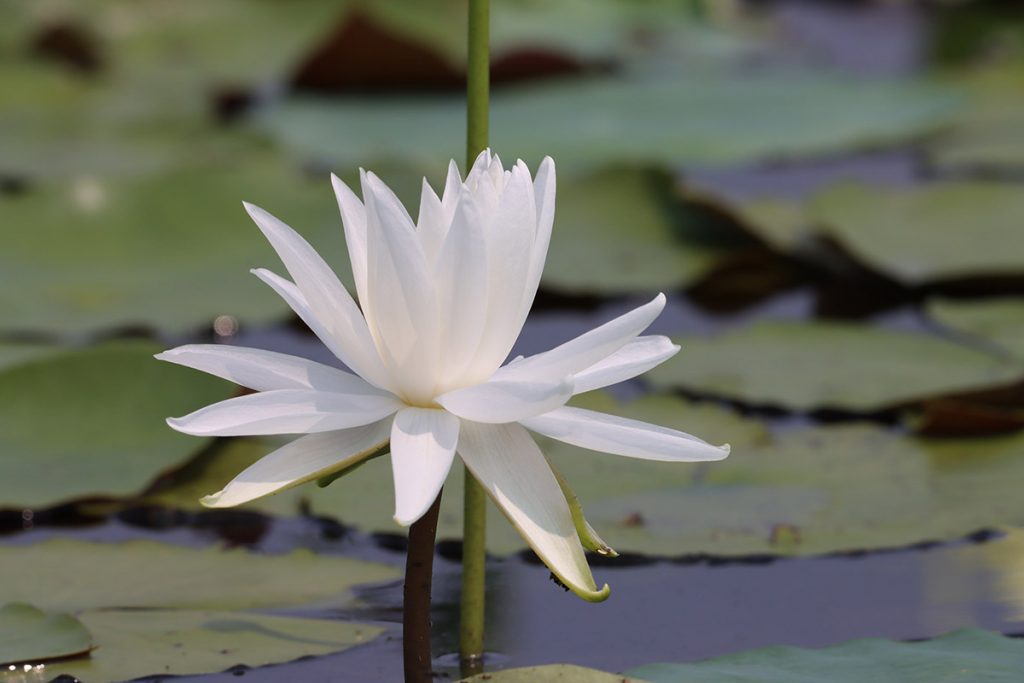
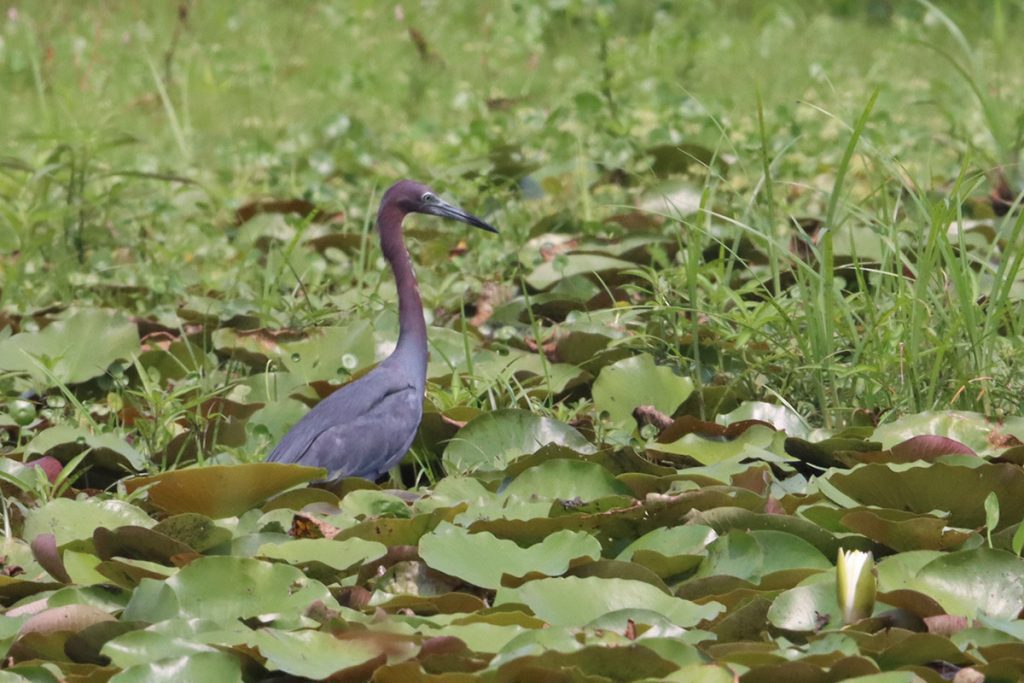
I went closer to midday, but next week when I don’t have drop off duty, I can show up while the birds are a little more active. The water is higher and covered in more vegetation, which changes the foraging habitat for wading birds. There’s more water, so aquatic animals have more space to love, and here they have the cover of the lily pads. More food, but more work for the heron?
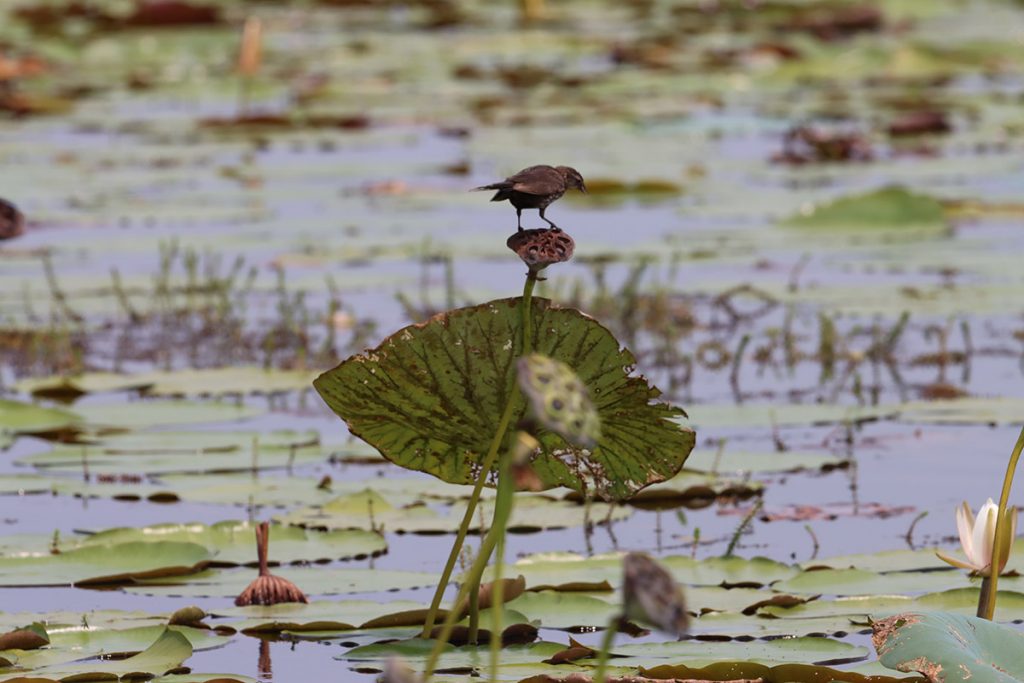
Meanwhile at Faulk Landing, the shoreline was full of flowers:
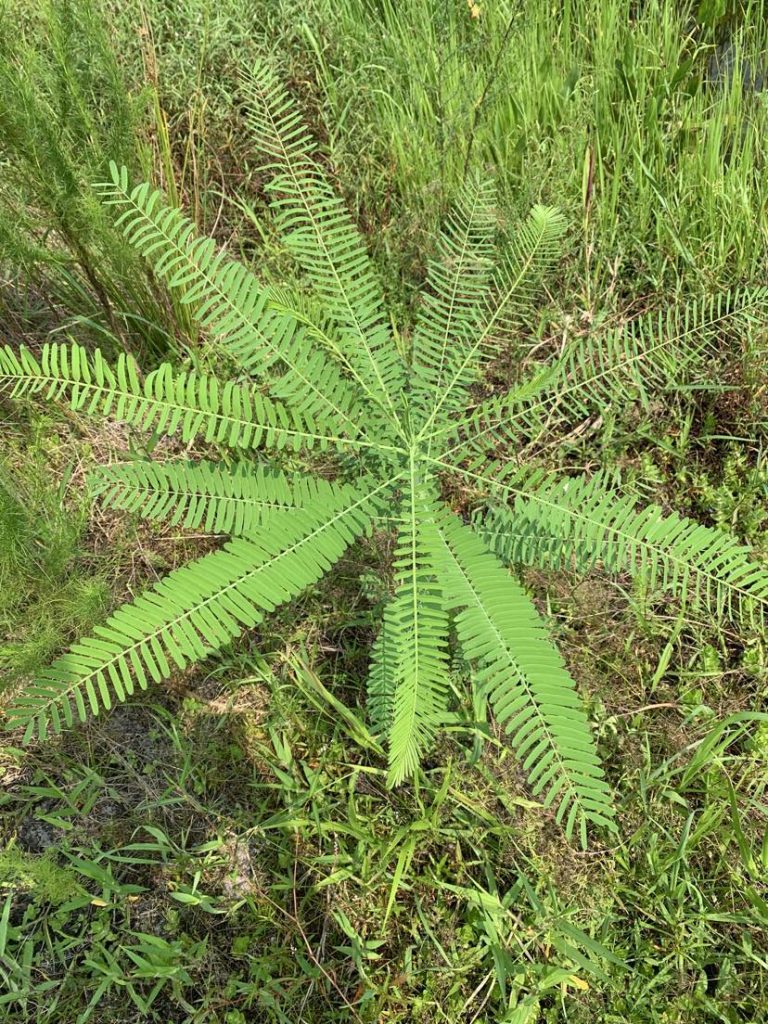
I know this one isn’t flowering, but it will be. I’m changing it in the earlier entry, but last month, when it was much smaller, this plant covered mudflats which are now inundated. I had identified it as chamberbitter, a nonnative that I pull in my own yard. It is instead the native bigpod sesbania, a different member of the legume family with a very similar leaf pattern.
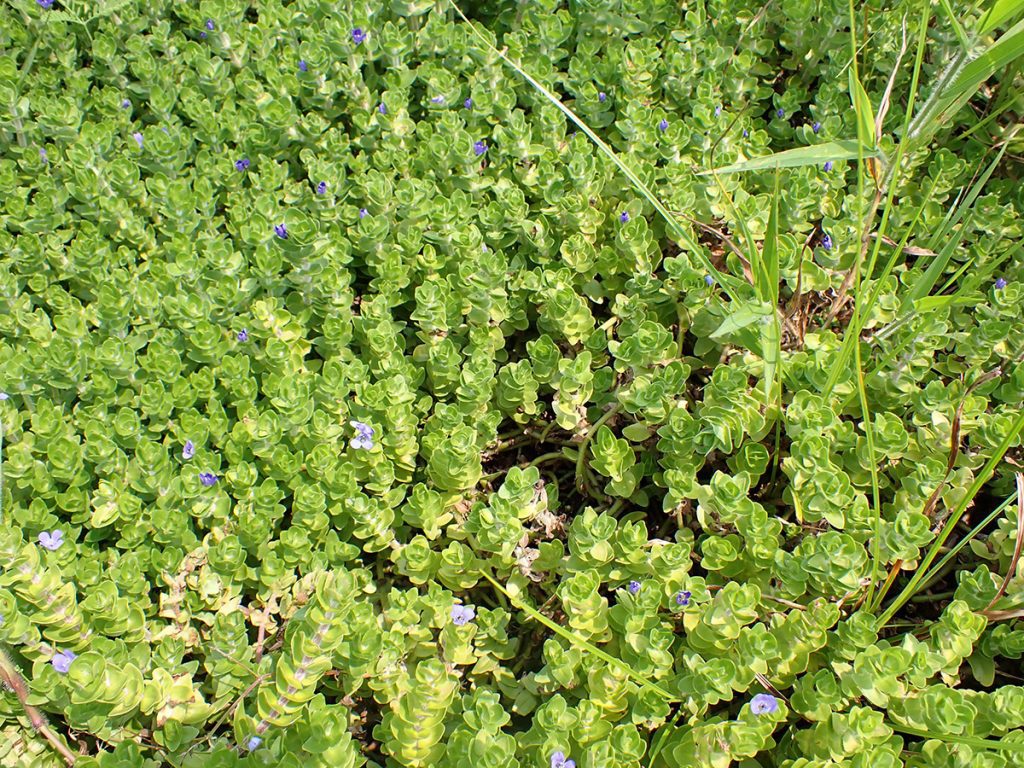
This pretty little thing covered the mucky shore. When we filmed the Leon County IFAS Extension make their wildlife pond, this was one of the plants they included: lemon bacopa.

Here’s a closeup of its cute little flower.

The margined leathering is a soldier beetle. As an adult, it’s a pollinator with a preference for white flowers, while their larvae are predators. Walking around, I also saw a few bees and wasps darting quickly between flowers.
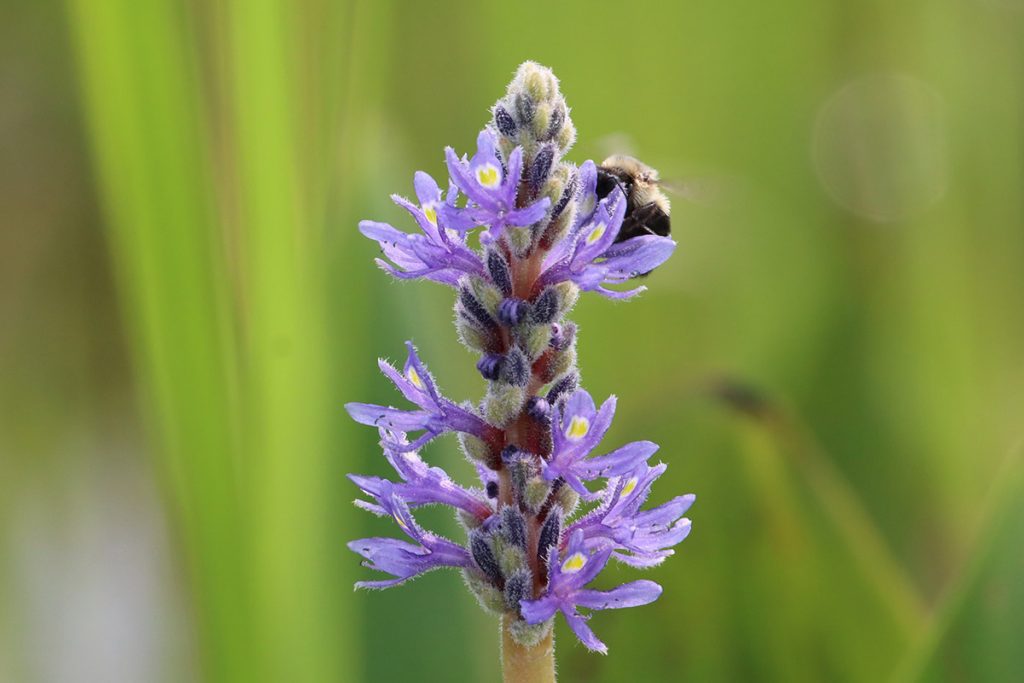
Here’s a common flower we see at the edge of lakes and rivers, but have you ever taken a close look at those purple flowers?
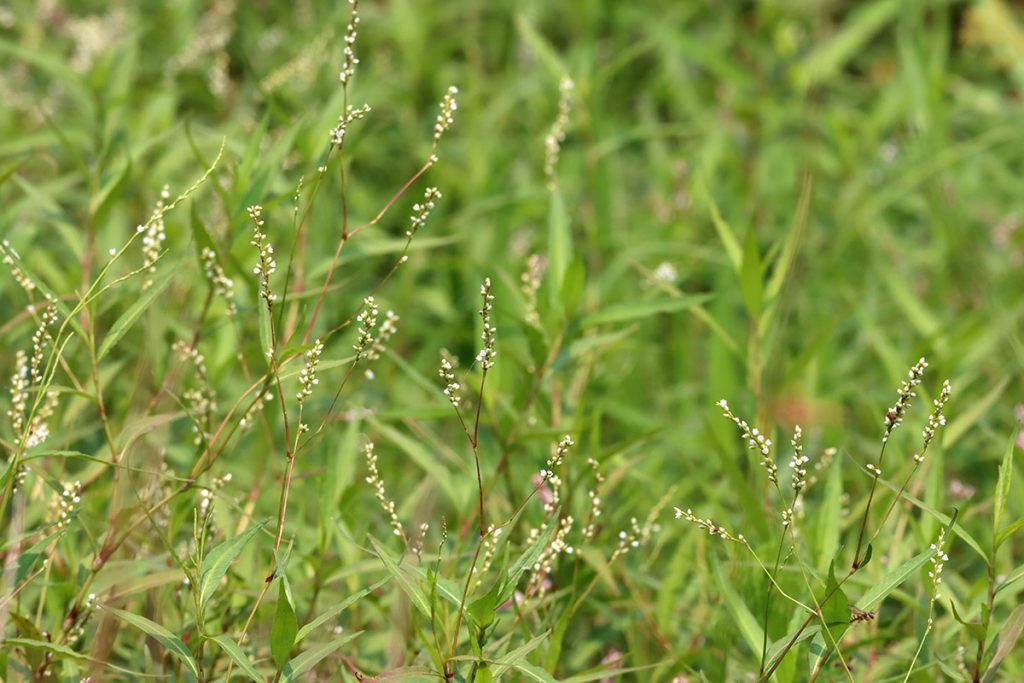
Lastly, smartweed.
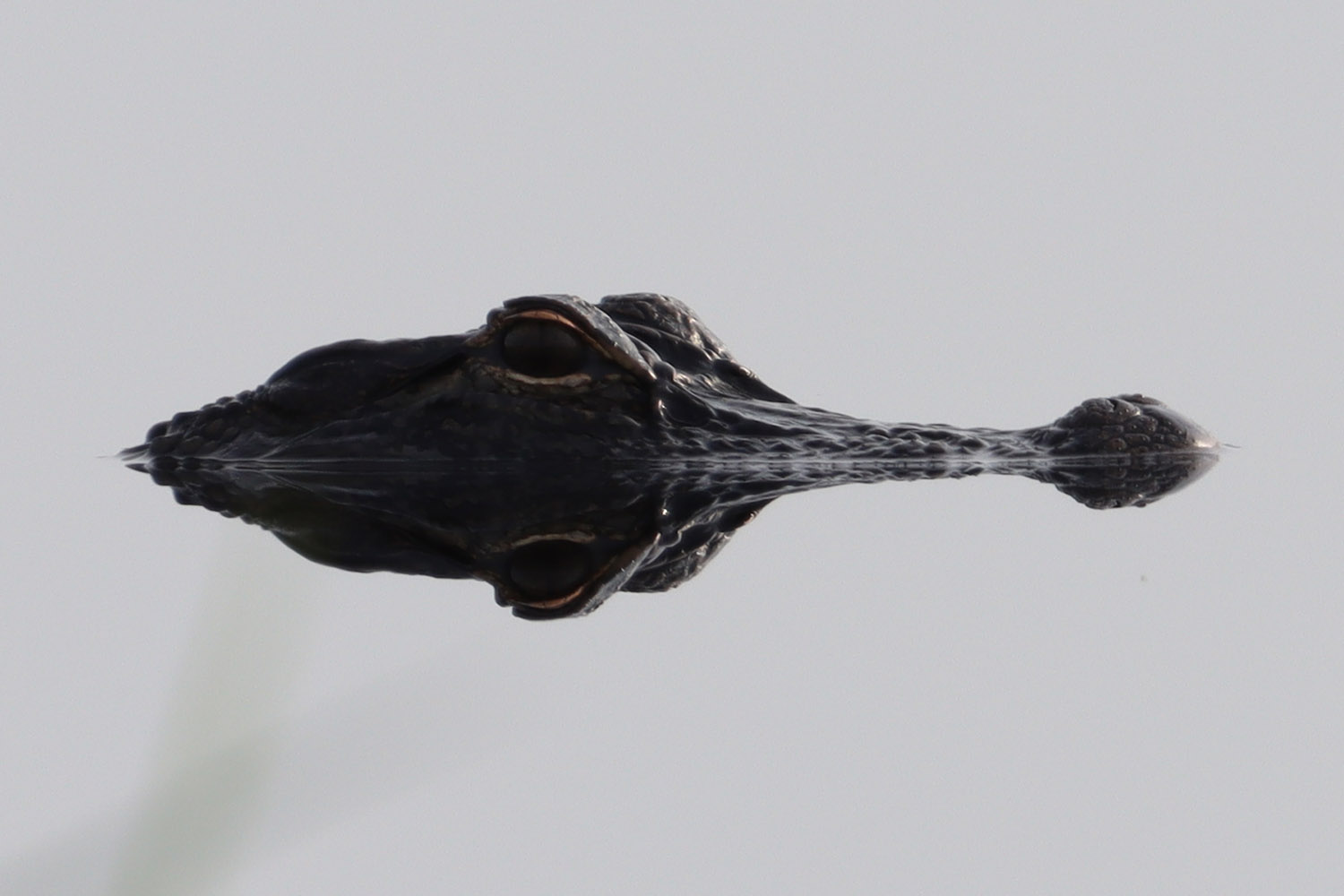
July 25, 2023
My friend in the water
I started my outing at Faulk Landing. The vegetation has grown thick. The paths around the lake don’t seem as well trodden as they had been. I’m used to seeing a couple people when I visit, but that hasn’t been the case in July. People are drawn to the sinkhole when the lake is drawn down, and it’s been full for a month. Also– it’s HOT.
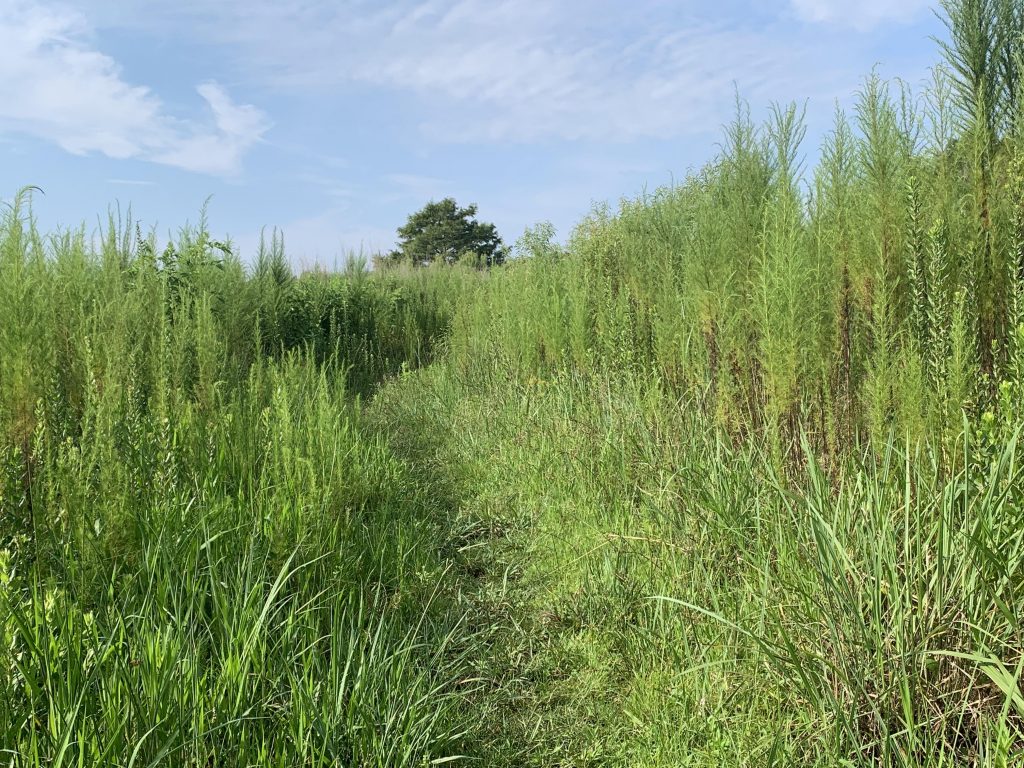
I think all Floridians know the shape in the water in the photo below:
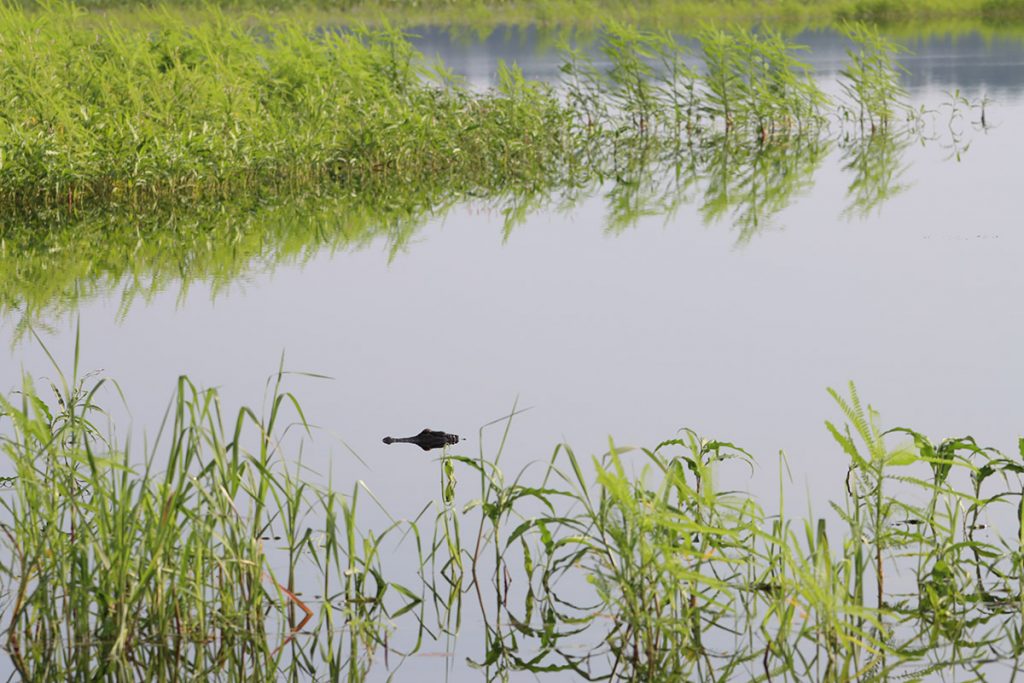
It’s almost imperceptible at a distance. But I zoomed in, and there it was:
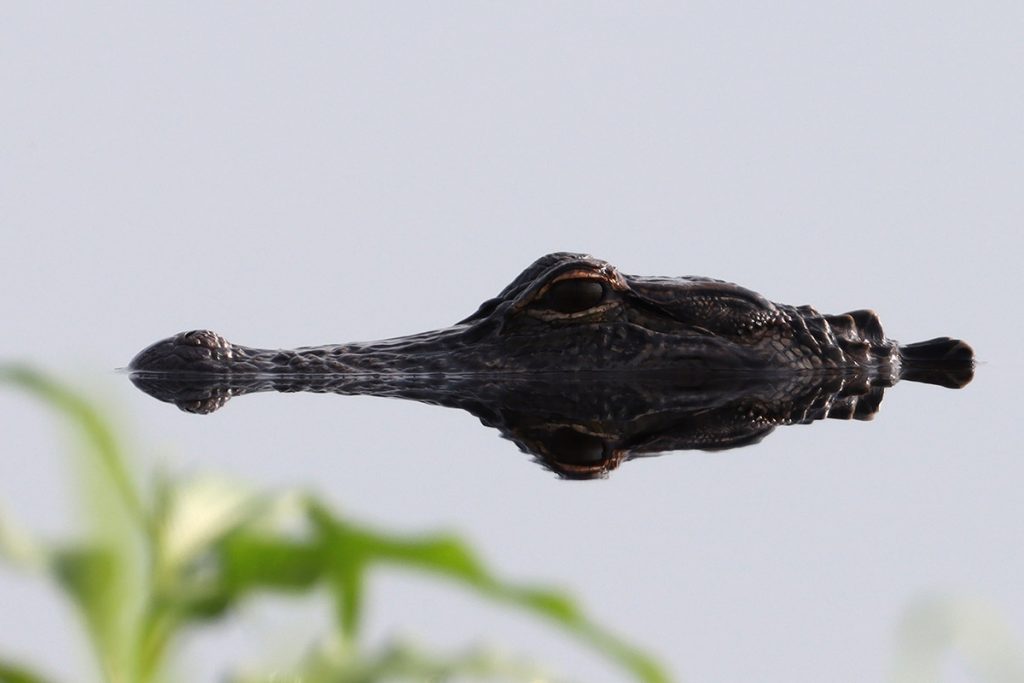
A short distance away on the trails that run alongside Lake Jackson in either direction from the landing, I found the following scene:
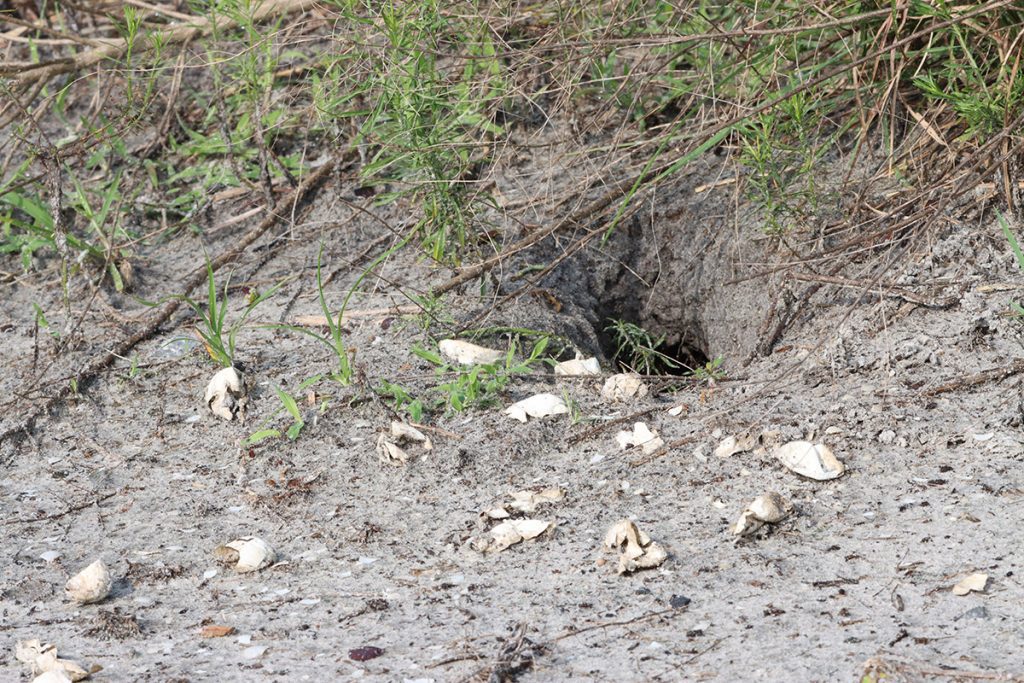
A little far from the water for alligator eggs. I’m thinking turtle eggs, but I’m not sure. I wonder if a raccoon dug them up and had a snack.
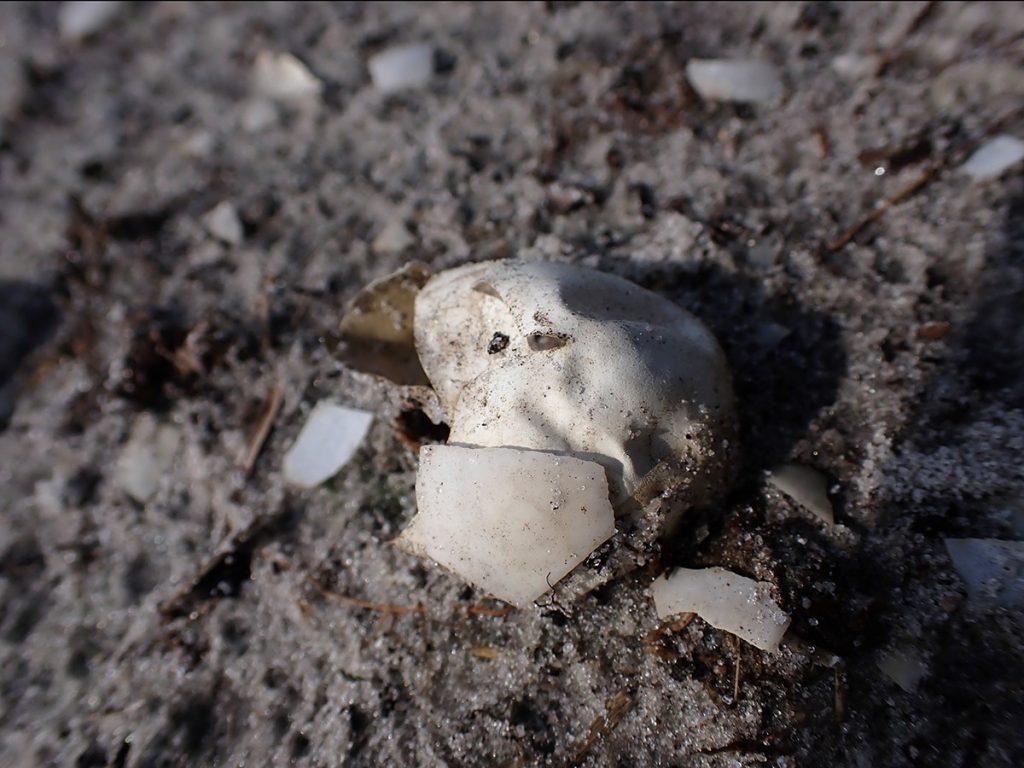
Here’s a closer look at the egg shell.
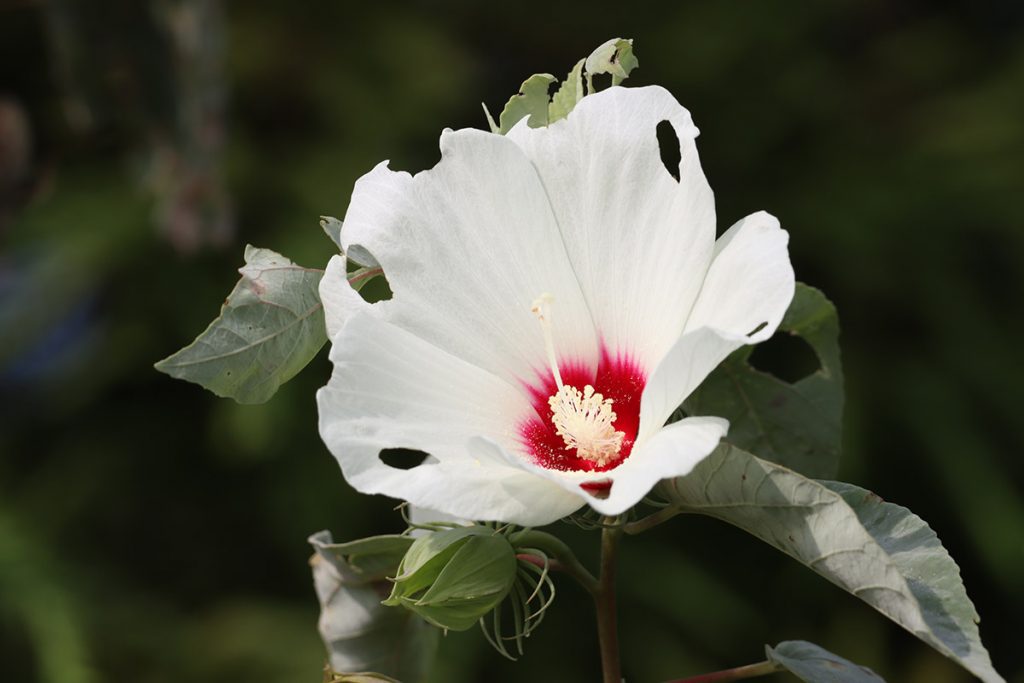
Near the nest, away from the water, one of the prettiest flowers you’ll see by the water’s edge. Something appears to have nibbled this one.
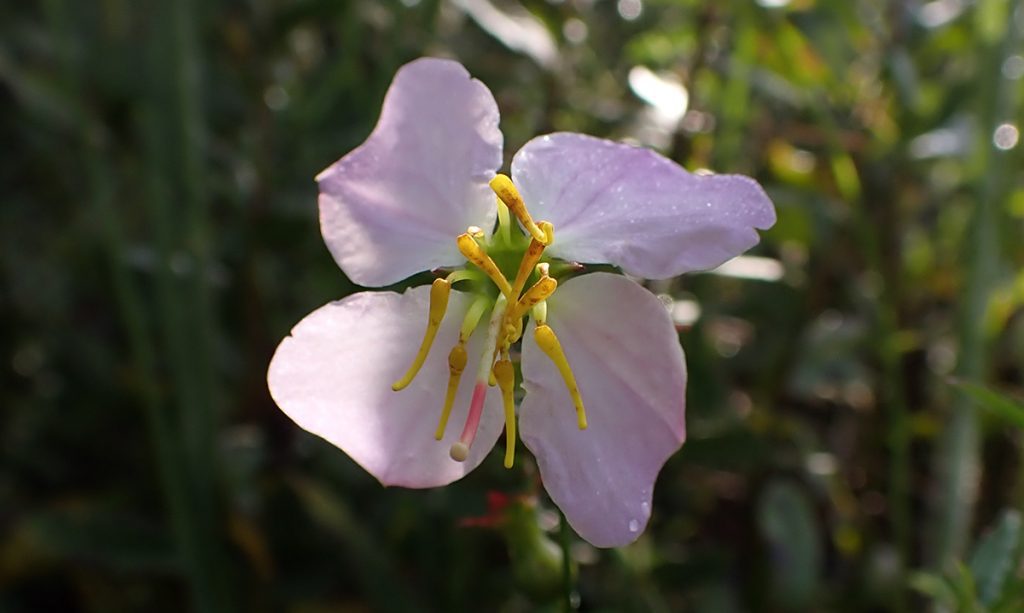
Another beauty.
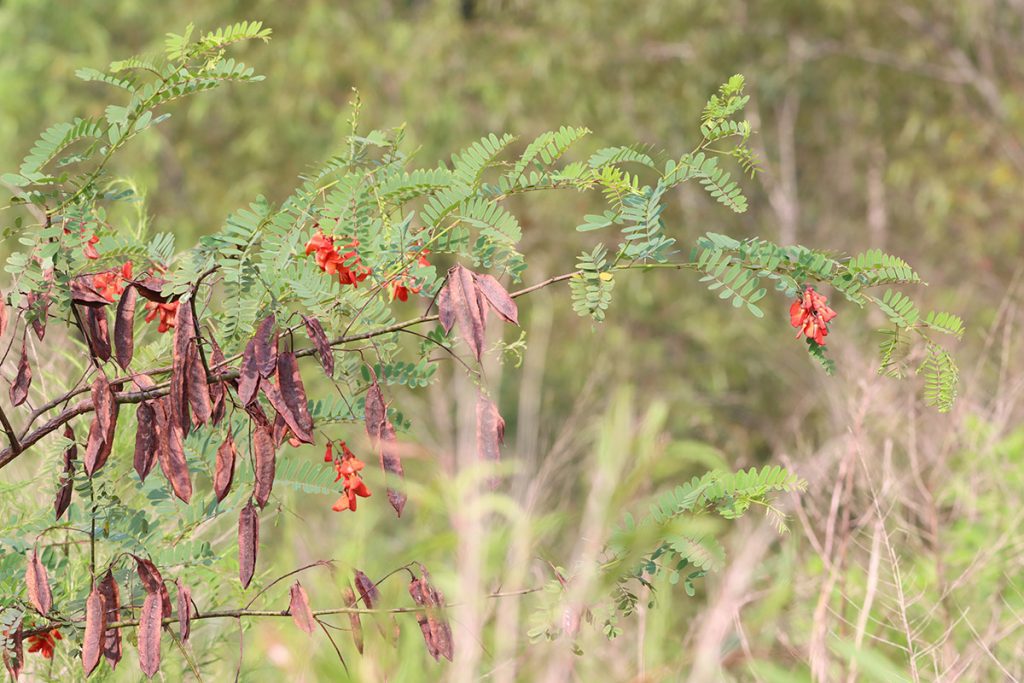
Here is one of a couple Sesbania species found along Lake Jackson. This is a nitrogen fixing legume, adding nutrients to the soil which surrounding plants can use.
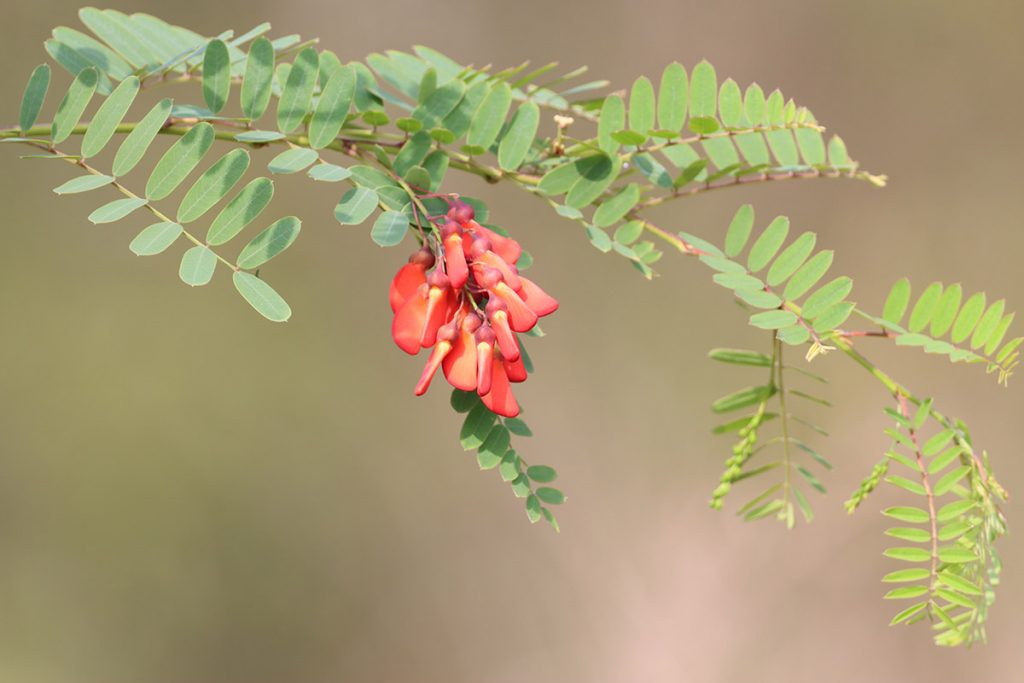

I next traveled to Crowder Landing, where I found a couple of my favorite pollinators.
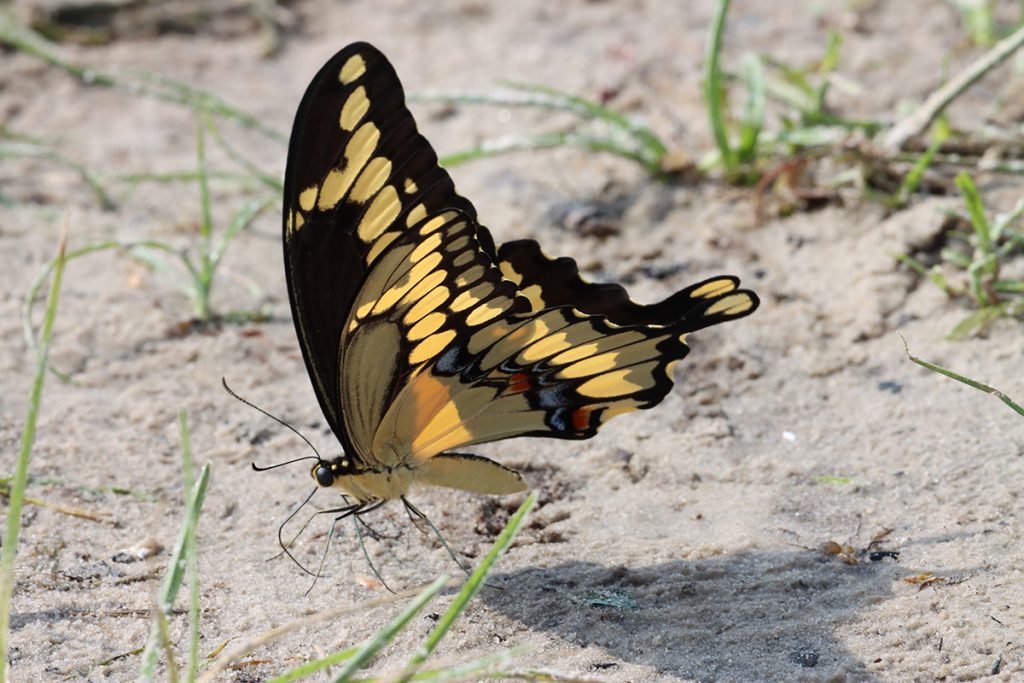
Butterflies sometimes seek out moist soils in search of salt and other minerals. They absorb the minerals and excrete the water. This is known as puddling. This spot was close to the water on the boat ramp. People who follow the Backyard Blog know my affection for giant swallowtails and their bird poop caterpillars. If you’re interested in the life cycle of these butterflies, I put together a short guide to these and three other species.

A related swallowtail species makes use of the pickerelweed on the shore.
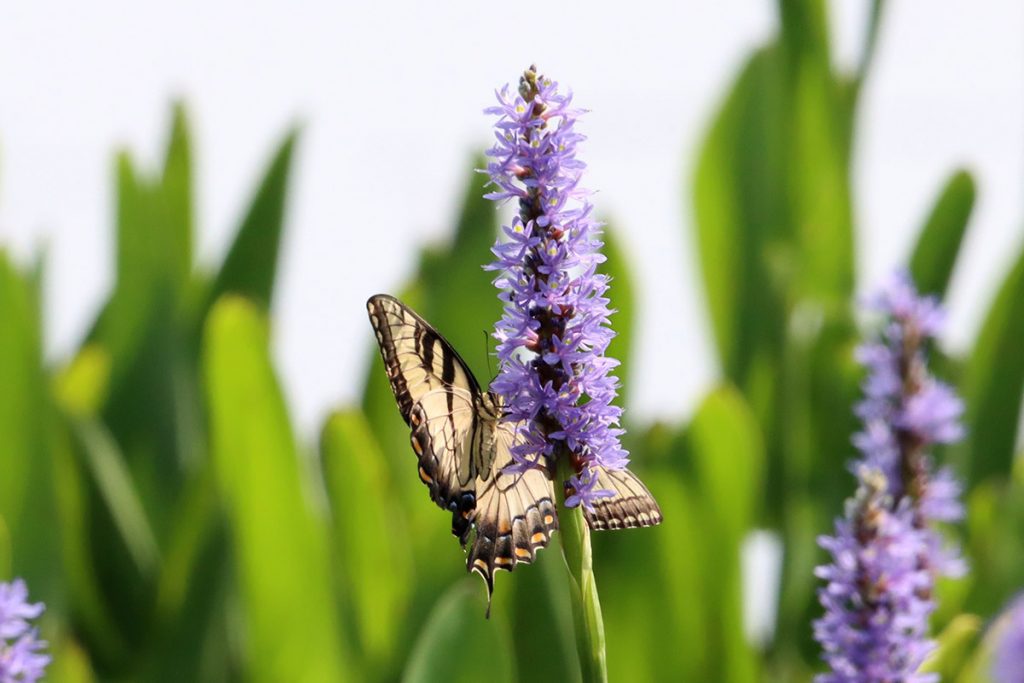
Here’s a closer look.
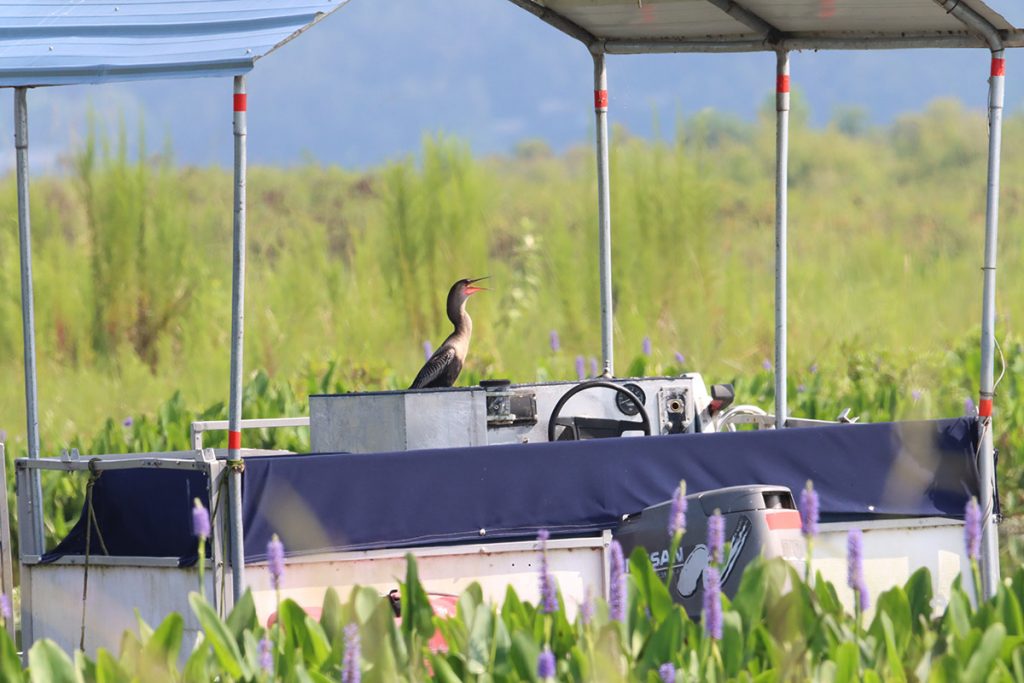
The area around the lake is public land up to the water’s edge at the point where the lake is considered “full.” It’s hard to say what that means on Lake Jackson. There’s no defined line, and it hasn’t been getting as full as it once had, so who’s to say where that line might be. A good rule of thumb is that, past the end of docks along the water, you are free to roam. Walking a short way, I found a creature who is perhaps not as respectful when it comes to private property.
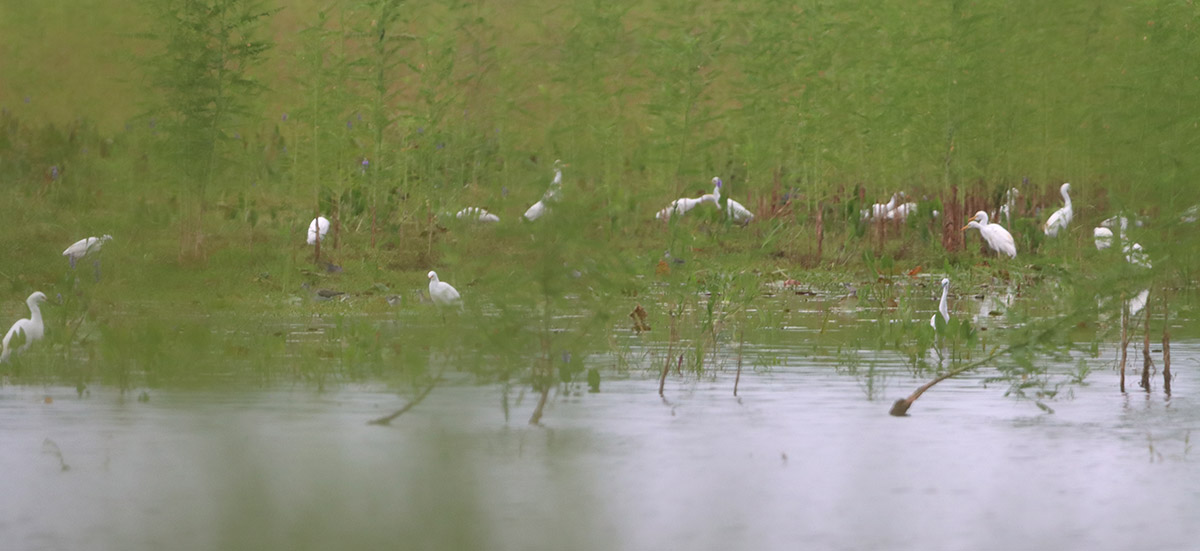
September 1, 2023
I missed another dry down, and a young hawk by the lake
I went out to sea for a large project I’ll be working on in the coming months. So I was out of town when Lake Jackson dried down a couple weeks back. It’s a more rewarding experience to be here when the water is about to go up or down, or just after it has. Nature shows you a few things when land and water are in transition.
It was a little quiet on this foggy morning, but not without a few sights to make the trip worth it.
I walked the paths that branch out from the former boat ramp area at Faulk Landing to do some exploring. They were flooded and a little overgrown. Good thing I brought muck boots.
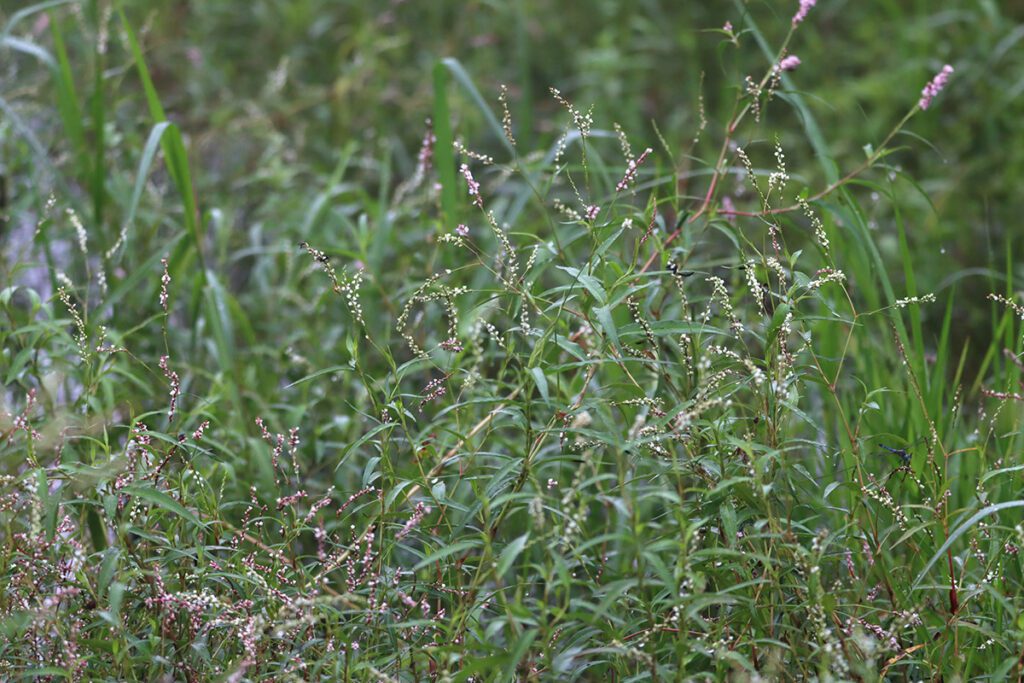
As in my own yard, late summer here has seen wildflowers take off around the lake. Smartweeds are common near water bodies and ditches, anywhere wet.
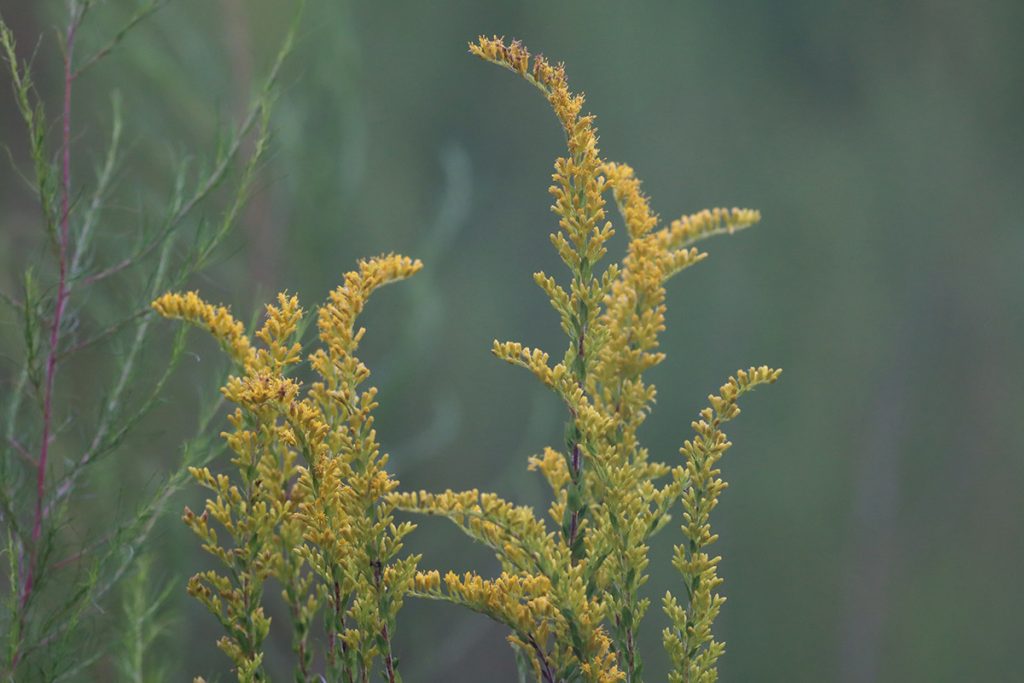
Goldenrod is known as the last flower to bloom before winter, but here’s an early bloomer. We’ll see more and more goldenrods start to flower between now and their peak bloom in October/ November when they’re a critical nectar source for migrating monarchs. It might be worth another visit in October.
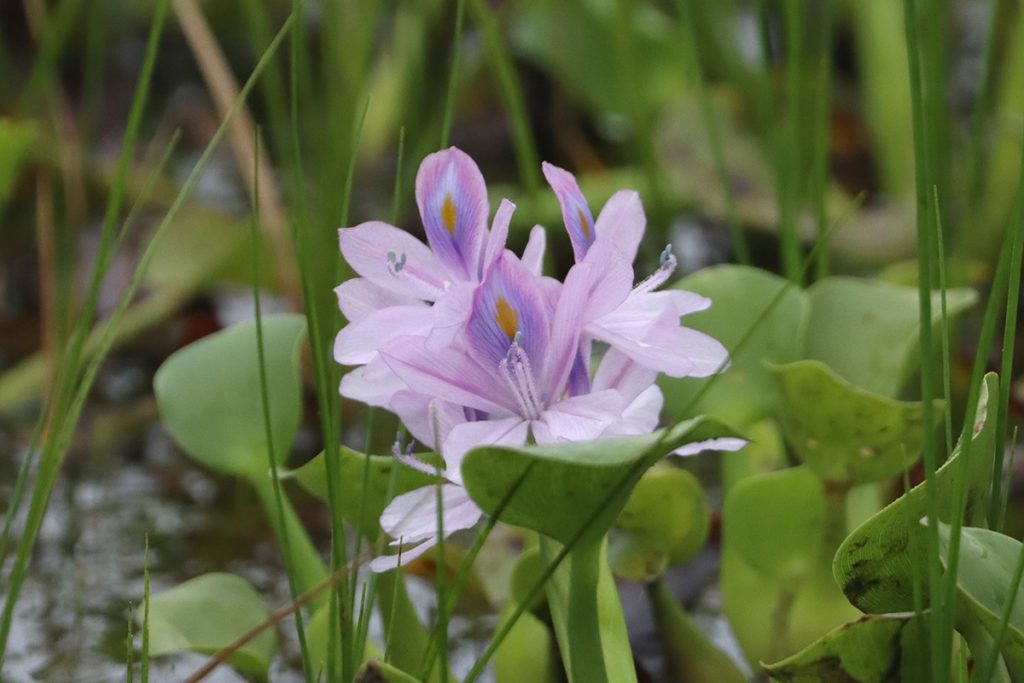
Along the trail lie a couple small, round ponds. In higher water years, these would be below the lake surface. My layman’s take on it is that these are karst ponds, depressions in the underlying limestone. Lake Jackson is a geologically active area, of course, and that extends beyond Porter Sink.
I saw this pretty flower floating in one pond, sadly another nonnative.
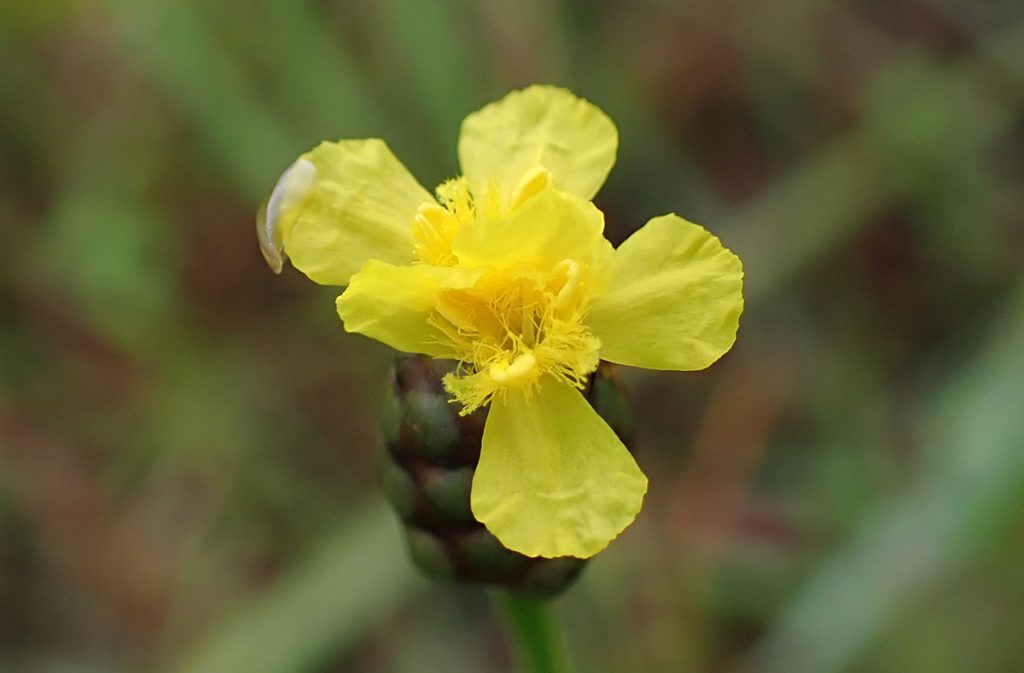
I fell in love with these minuscule yellow flowers, growing on long stalks out of the standing water on the trail. Our area has many species of yellow-eyed grass, and I’m nowhere near knowledgeable enough to take a guess. Life goals. The beauty of learning about the flora and fauna of our local ecosystems is that I will never run out of new things to learn. I learn about the individual species, their relationships to each other, their relationships to the land and water. I can never know it all, and so there will always be something new.
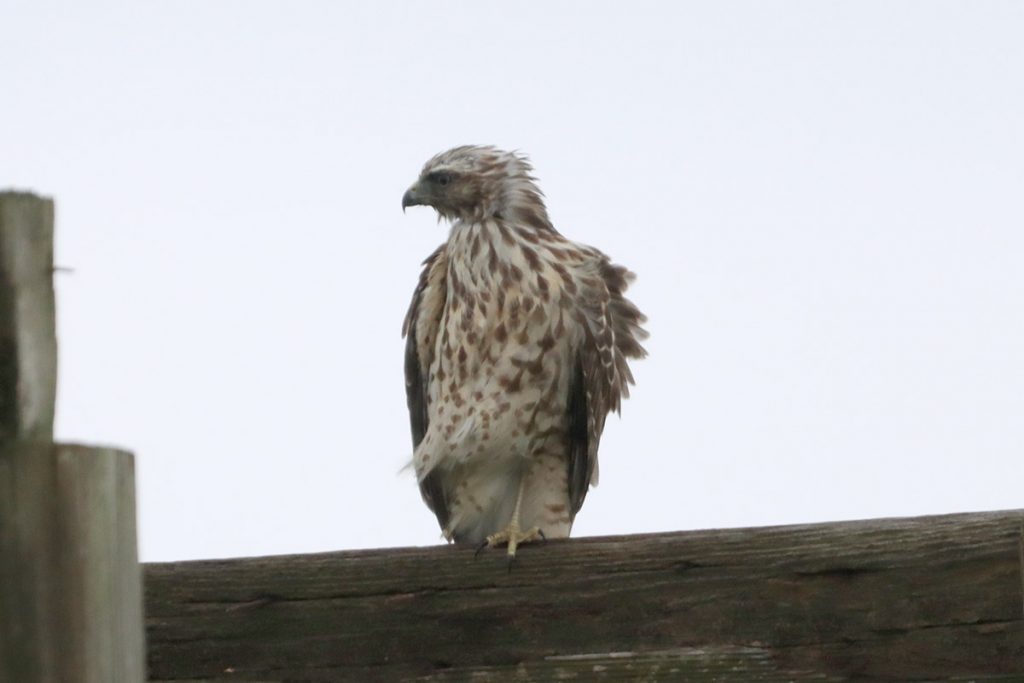
Near the Lake Jackson Weatherstem station, there’s this wooden structure that I think might once have been associated with a dock. It’s hard to imagine the water used to reach here, and might still again.
I’m not an expert on juvenile hawks, but after consulting the Cornell All About Birds site, I’m fairly certain this is a red-shouldered hawk. You hope for something more exciting, but this is the raptor we’re most likely to see in our area.
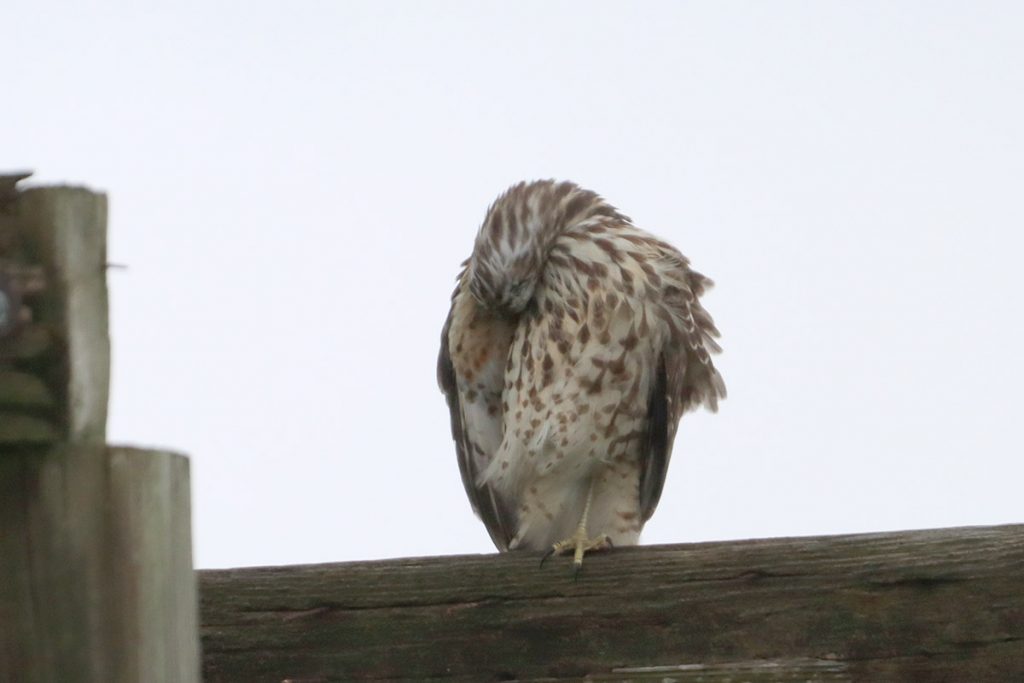
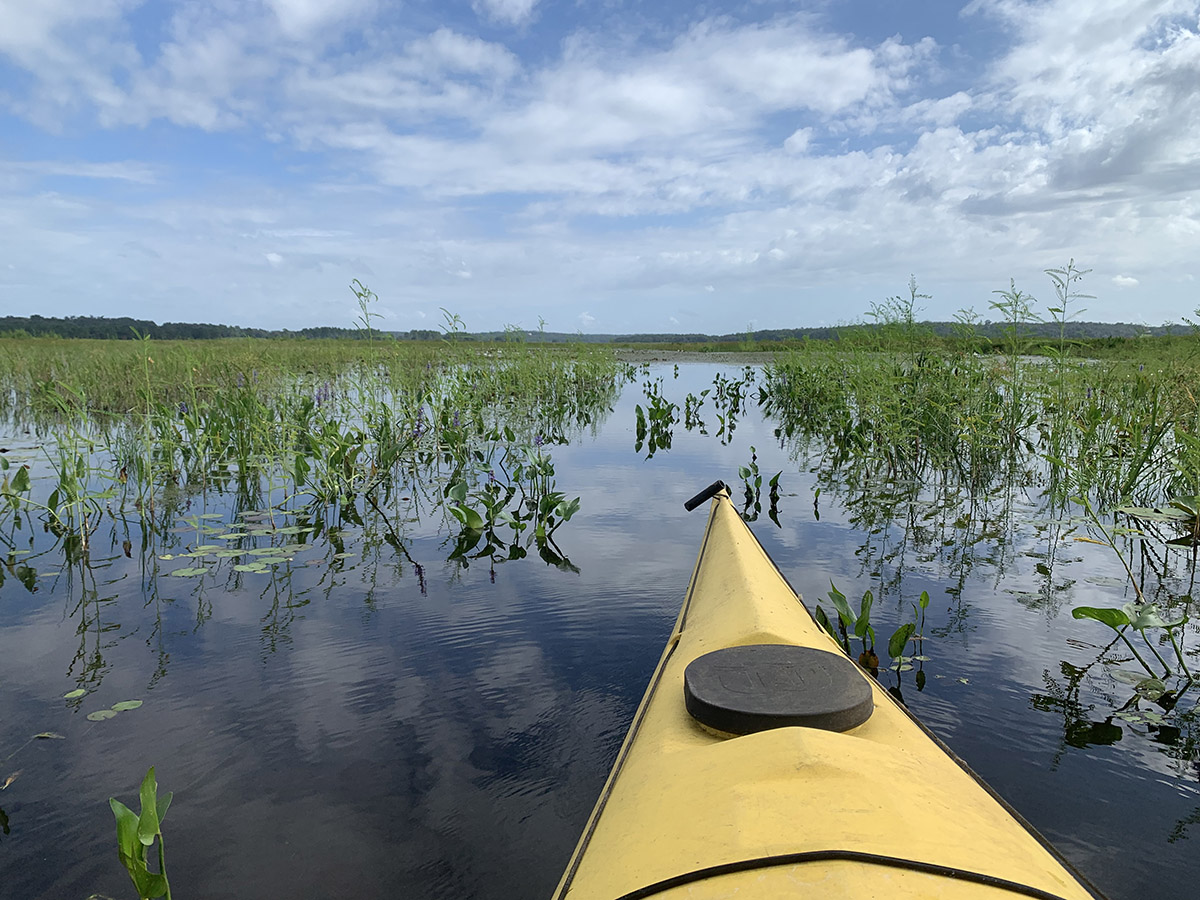
September 3, 2023
A quick, shallow kayak trip
I’ve been wanting to paddle out over Porter Sink, and so I thought I’d try now that the water’s up. I’ve never kayaked Lake Jackson, so let’s just count today as a learning experience.
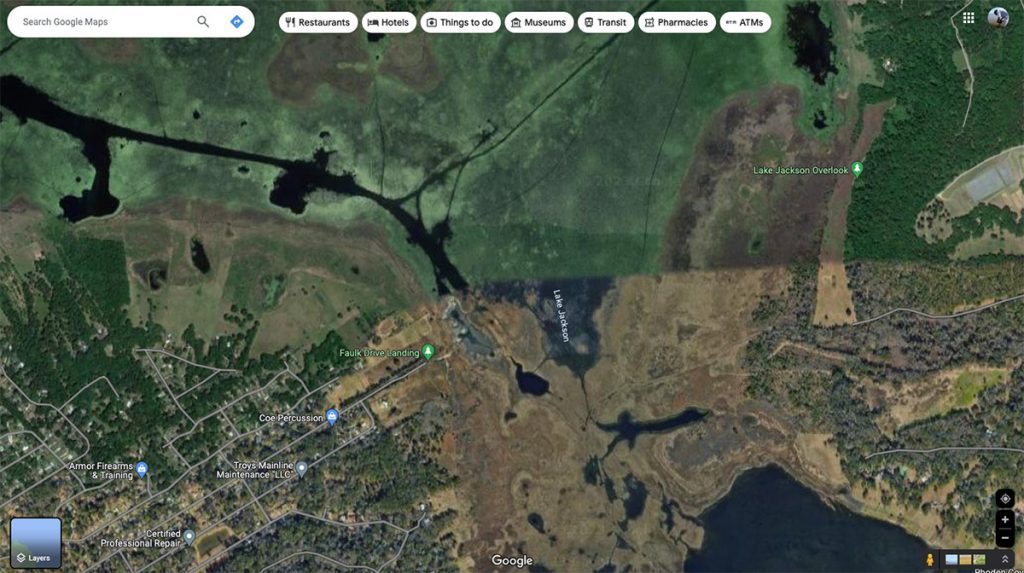
I called up Google Maps to see from which direction I’d want to approach the sink. I chose to start at Jackson View Landing off of Munroe Street. Just off the ramp, there is an open area that leads into a narrow path through grasses and other vegetation to the sink area. The way Google patches together satellite images to make a map, today it was priceless. My sci-fi/ fantasy fan brain wanted to cross that threshold between saturated and dried-down lake.
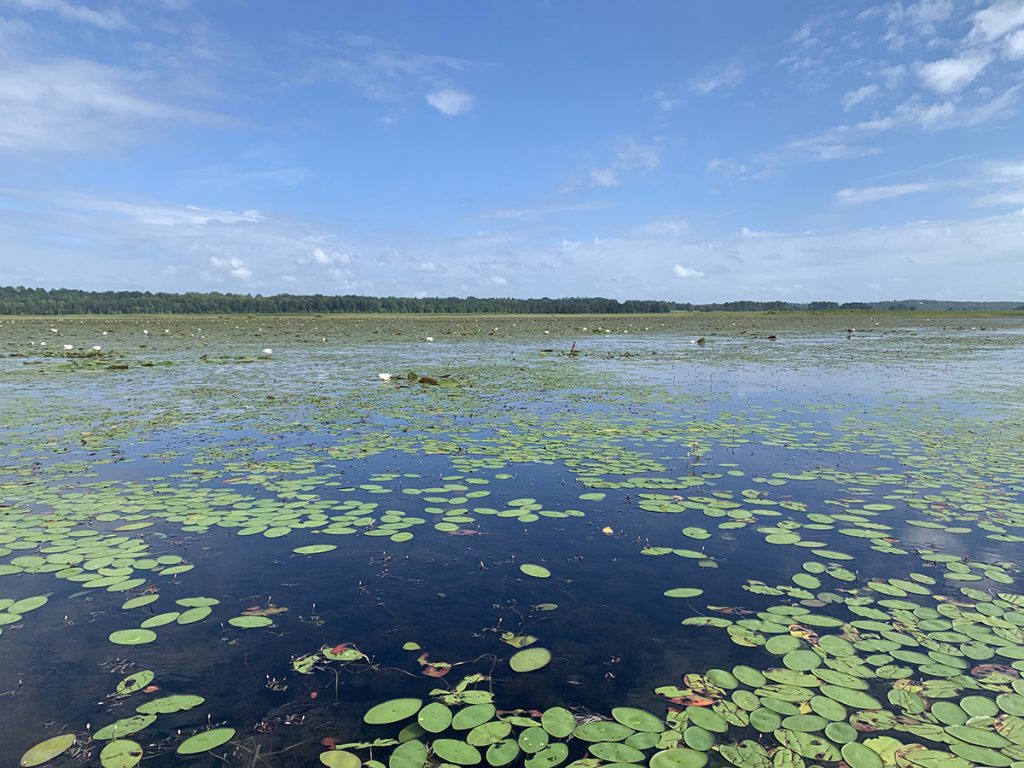
There’s more water in the lake now, but the level is still pretty low. It doesn’t reach the end of the paved boat ramp, actually. A couple pickup trucks have driven down onto the unpaved area closer to the water to put in jon boats. I strapped my kayak onto my elderly Honda Civic, a car too low to make it past the hump at the end of the ramp. So I carry my boat down from the parking lot.
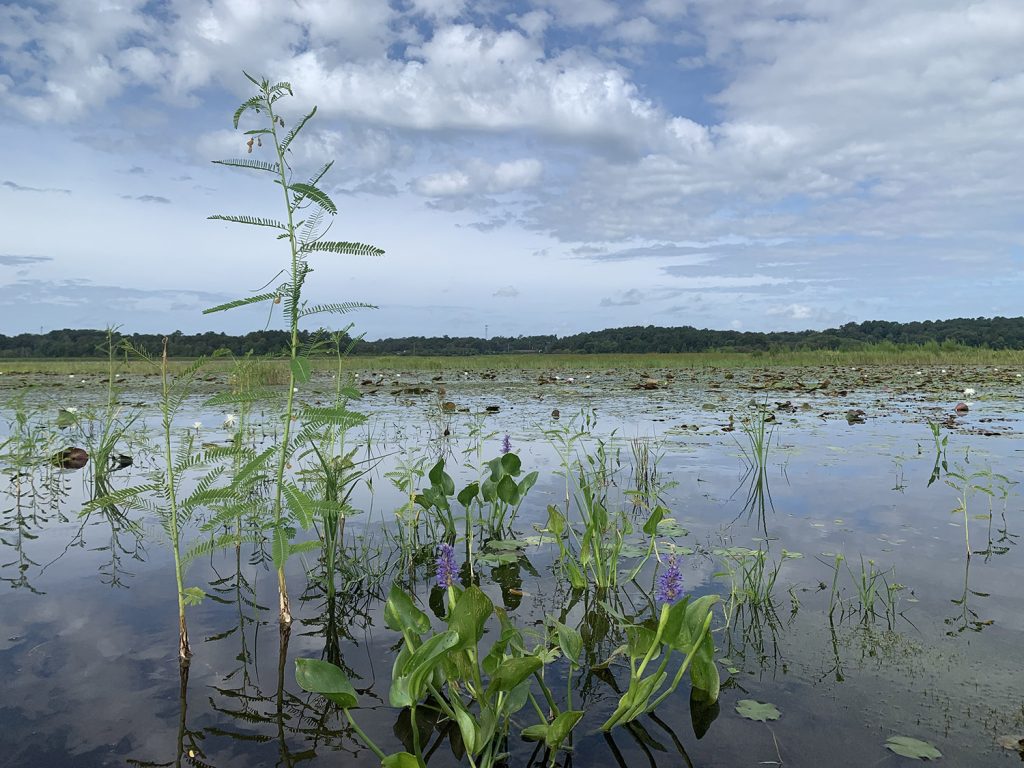
Just as the fringes of the lake are filling with flowers, so is the lake itself.

You can see the path through the lily pads. Past there is a channel through the grass, which curves right and heads towards the sink. That was where my journey ended. There’s not enough water yet to make it from this direction.
I drove over to Crowder Landing. Here, the area below the ramp is larger and rougher than Jackson View. The morning is not quite as cool as it had been, and my yard needs a little love today. I decide to try again in the winter when the plants are dormant, and drink less water. As Cait Snyder tells me, this is why the lake stays fuller in the cold months.
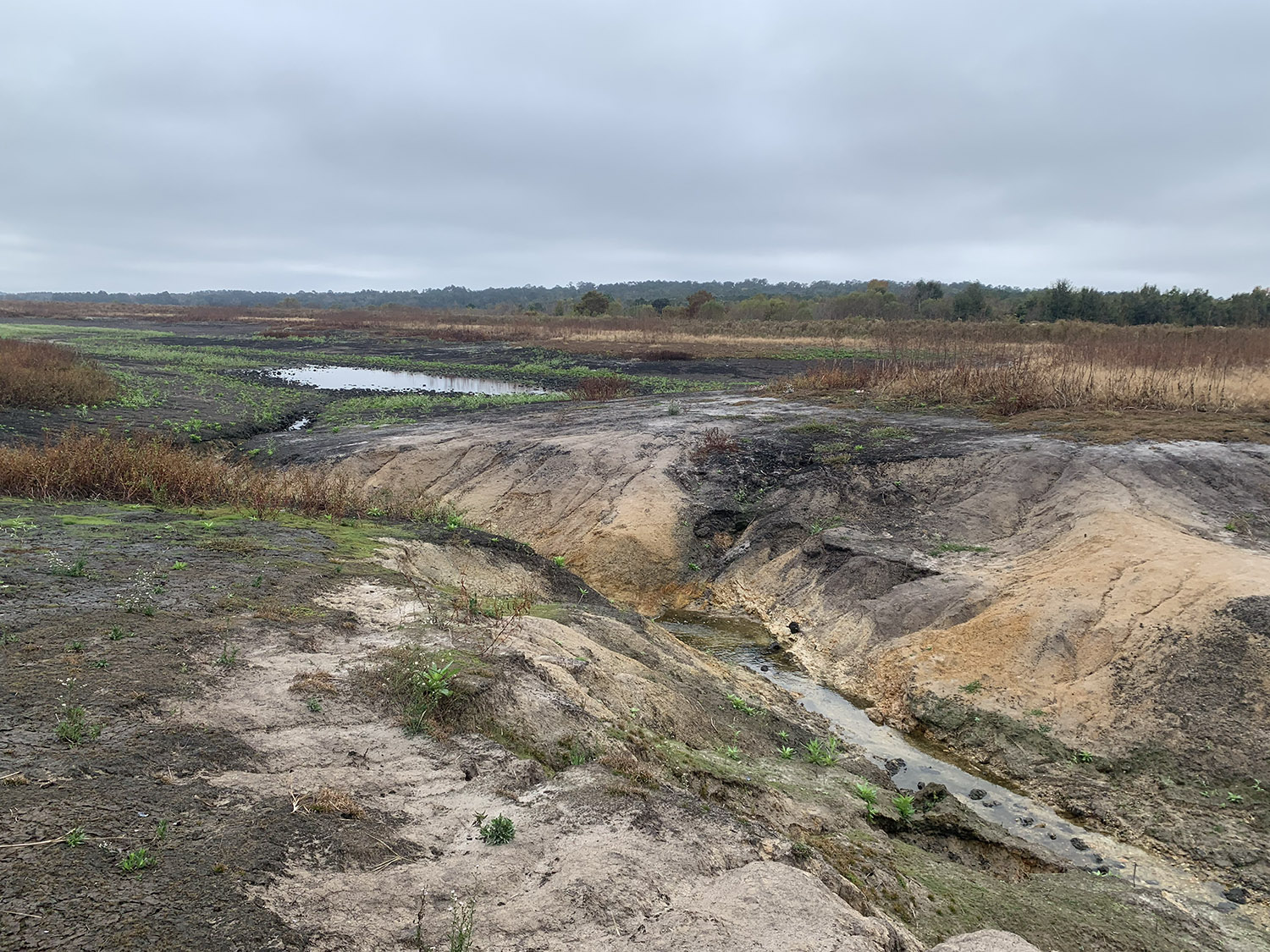
November 17, 2023
Lake is down, fall wildflowers
A couple of weeks ago, Lake Jackson dried down again. Today there is a contrast between the new green growth on newly exposed soil and the vegetation at the edge of where the water had been, which is turning brown.
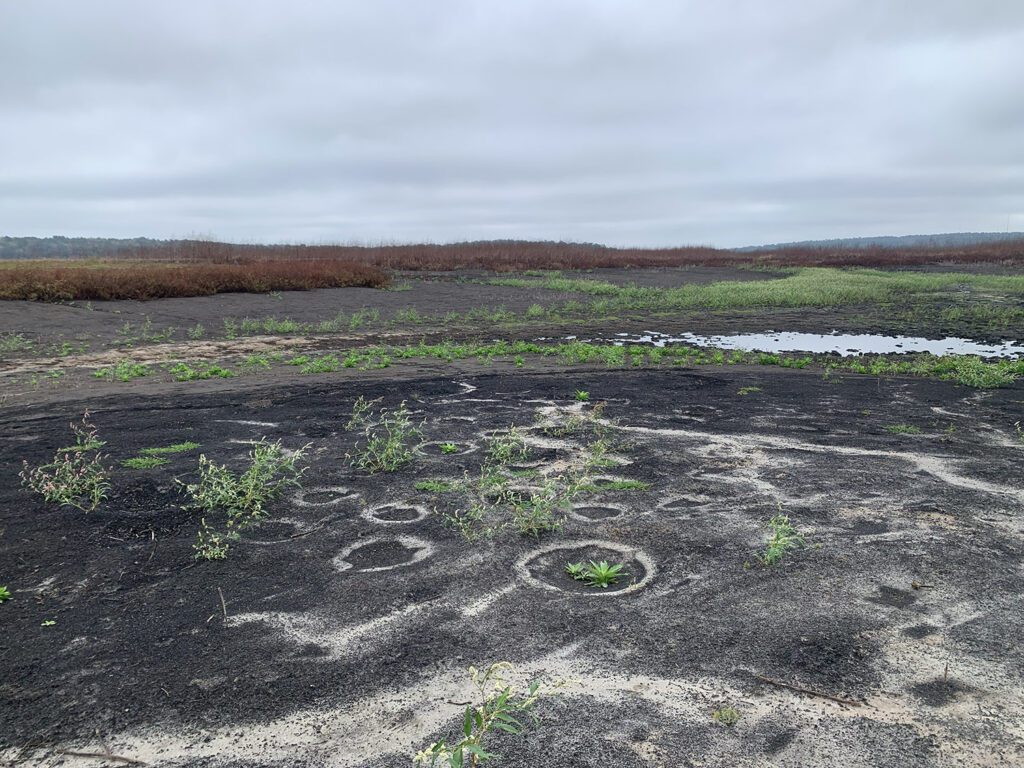
These fish nests are near the former Faulk Drive Landing ramp, and it’s a spot I like to revisit and photograph over time. I’m surprised how well they’ve kept their shape over the past year-and-a-half as water moves on and off of them. Much of the new growth we see is wildflowers, providing additional nectar sources for some of the last pollinators flying in the fall.
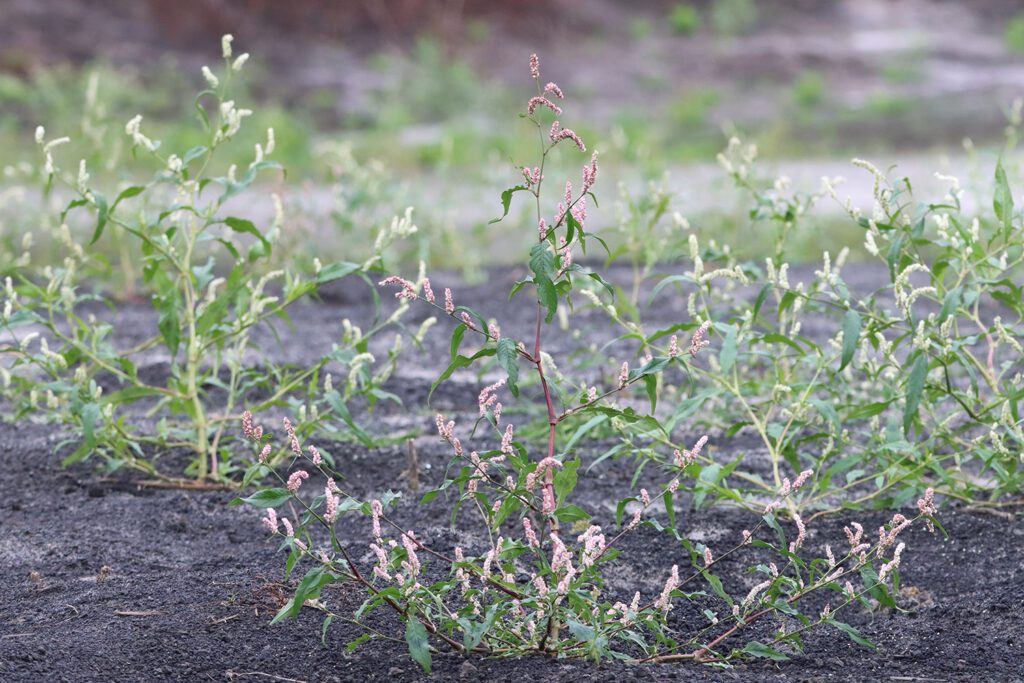
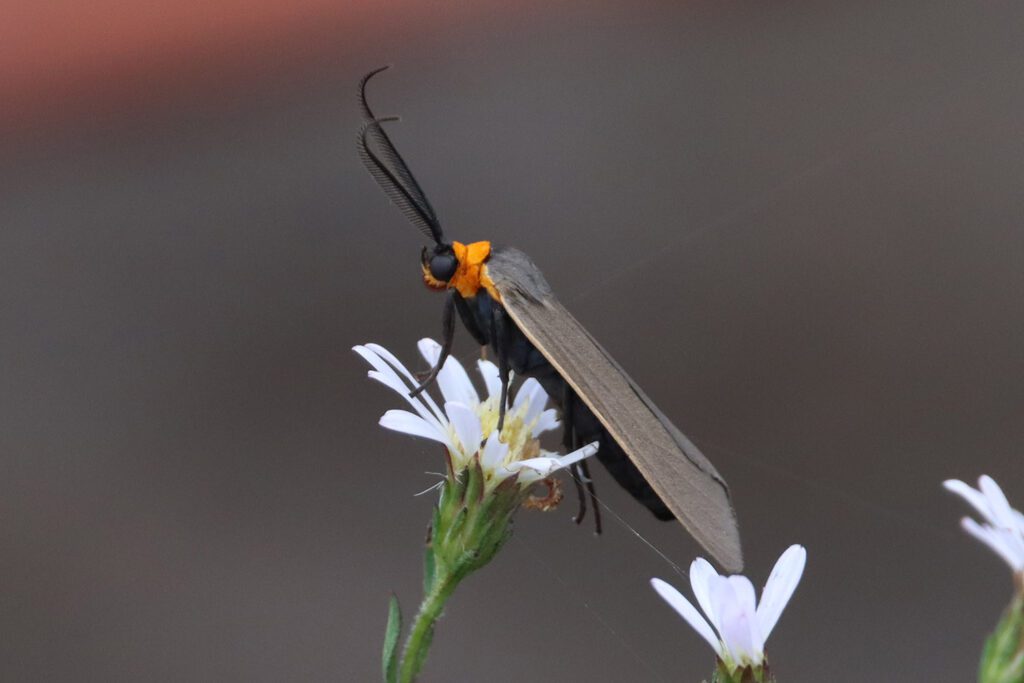
This is a moth whose caterpillars feed on grasses and sedges, which makes a prairie lake an ideal habitat for it.
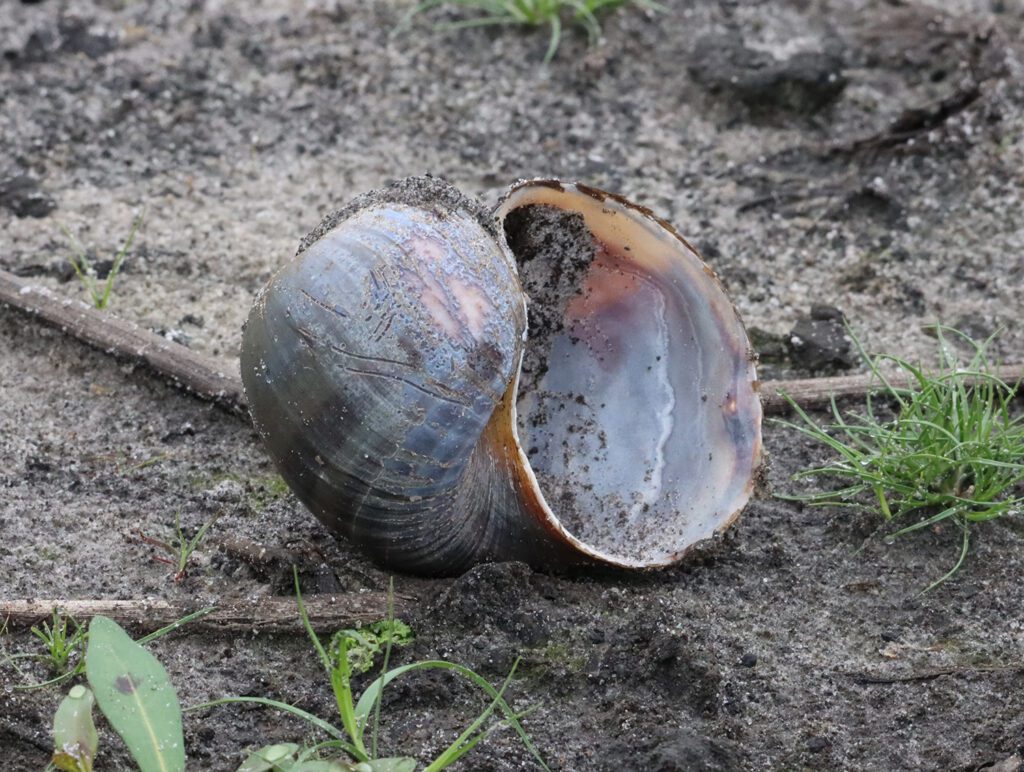
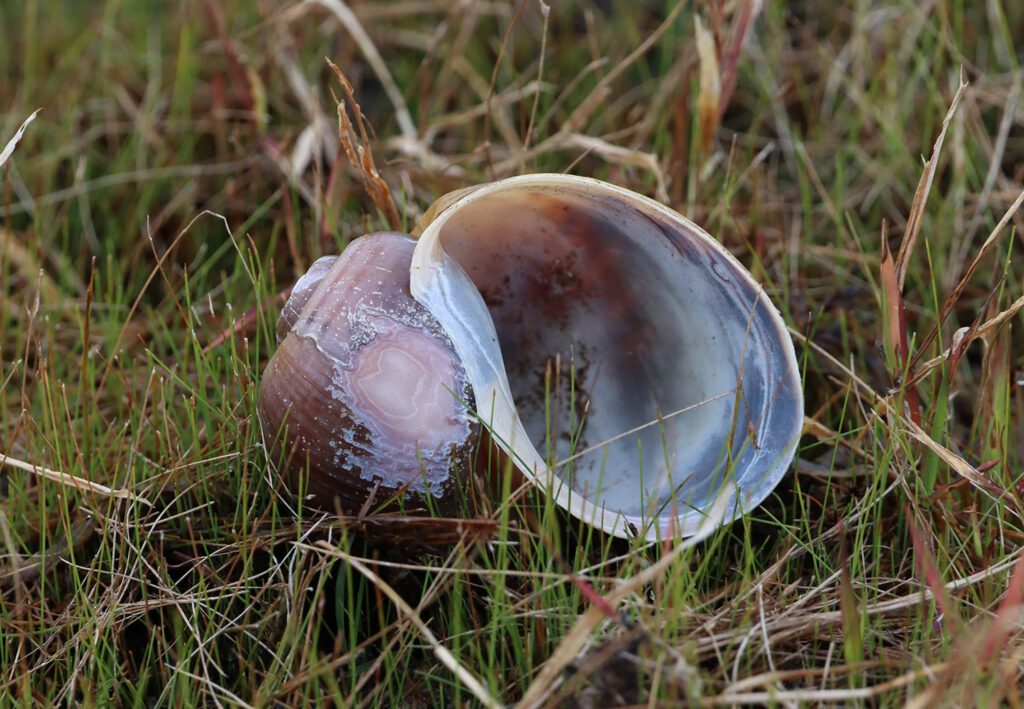
Island apple snail shells were strewn about the lake bed. They are an invasive counterpart to our native Florida apple snail, the animal whose niche they’ve usurped. The nonnatives are destructive to native vegetation, but they do feed limpkins where their native food source is absent. It looks like I missed a limpkin party here near the former Faulk Drive Landing ramp.
As always when Porter Sink is exposed, various basins in Lake Jackson still hold water, sending various small streams into the sink basin. I walked upstream to the large, shallow wet area at the other end of this stream and watched a great blue heron walk very slowly.
A few months ago, I recorded video of a great blue heron eating a large salamander (you can scroll up to watch if you missed it). I watched expectantly as it moved slowly through the water. I felt as if it might spring into action at any moment. It’s moving in a way to not agitate the bottom and scare any potential prey. Walking and watching, a predator at work.
After a while, I figured the heron wasn’t imminently going to strike, so I headed back. Near the old ramp, a greater yellow legs didn’t fly off as I approached the mucky pool feeding into the sink basin.
I watched this migratory shorebird bob its head for a while before heading out.

